This is an annotated version of the
Early Black Firefighters of North Carolina web site, which is no longer
available. It was researched
and created in 2005-06 by the late Chuck Milligan, retired
Captain, Durham Fire Department, 1977.
Early Black Firefighters of North Carolina, Annotated
Written and researched by Chuck Milligan
Return to Home Page
Cities and Towns
Contents
AYDEN
Ayden was mentioned by John Bizzell as having a black fire company. There
has been no documentation at this time.
Sanborn Fire Insurance Maps dated 1916, 1919, 1925,
and 1939 do not list the ethnicity of the town's volunteer firemen.
top
BEAUFORT
Documents show Beaufort as having black firefighters as early as 1908 with
20 members manning a hand engine and a hose reel. 1913 gives the same numbers
while records for 1924 show 21 members manning a hose reel with the hand
pumper gone.
The Beaufort News on May 6, 1943,
included a retrospective that cited a fire in 1907 or 1908, "when the new
[fire department] was eleven months old." The newspaper at the time reported
that the Robert E. Lee Fire Company and the "Colored Fire Department"
battled a blaze at the Robinson House on the northwest corner of Ann and
Turner streets, in which "Miss Henrietta Roberson was burned to death." The
fire engine was connected to "the fire plug on the corner" but "as the water
did not come promptly," the engine was moved to water front at Turner Street
and "the hose thrown overboard."
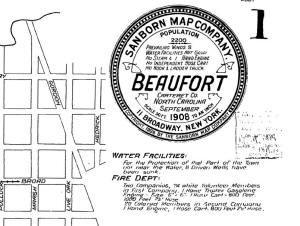
Sanborn Fire Insurance maps from December 1913
list Beaufort's second fire company as colored and housed next to Town Hall at
305 Broad Street, with 20 volunteers, one hose reel with 800 feet of 2
1/2-inch hose, and one hand engine.
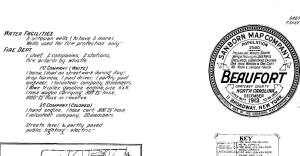
Sanborn Fire Insurance map from 1924:

top
CHARLOTTE

Colonel Charles Samuel Lafayette Alexander Taylor
Photo donated by James Richardson, Col. Taylor's charge
at an early age.
Much like other larger cities in the state, Charlotte enlisted slaves
in the fire department before the War Between the States. At some point after
the war two black companies were formed with the Neptune company continuing
until 1907. The Neptune company furnished leadership for the North Carolina
Colored Volunteer Fireman's Association. One prominent figure of this
organization was Colonel C.S.L.A. Taylor. Taylor was the only black colonel
in the Spanish-American war from Charlotte. His leadership ability helped
him to serve as Financial Secretary of the state organization for a number
of years.
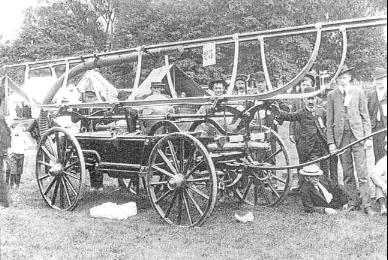

Hand engine of Neptune later restored by Newbury Mass. Photos courtesy of
Doug Hickin, Charlotte, NC Fire Department.
African-American Influence in the Charlotte
Fire Department
Even in the days of slavery Mecklenburg area residents would not tolerate
the mistreatment of animals or slaves. Anyone rumored to be guilty of this
type of behavior was shunned by the rest of the community. This may have
come from the Quaker influence. The great wagon road from Pennsylvania funneled
early settlers into the western piedmont and foot hills. Charlotteans then
as now had a much different idea of how thing should be done.
Many of the slave holders felt the need to educate their slaves and because
of this when emancipation came they had an advantage when they faced their
new found freedom. In the span of only 30 years many former slaves had risen
to positions of authority both in private and political life. They were quick
to take their place in civic endeavors.
No greater cause can be found than to come to the aid of a fellow man in
time of distress. Fire was a devastating threat and water the only reliable
extinguishing agent. Every firefighting operation was labor intensive. Using
manpower to move water can be extremely tiring. To be a volunteer fireman
in this era was for the physical and mentally fit.
One young man stands out above all others. Charles Samuel LaFayette Alexander
Taylor was born in Charlotte in 1854. He was educated in a Quaker school.
He was an accomplished musician, a dancing master, a shoemaker and a barber.
He taught ballroom dancing to the prominent white ladies of Charlotte. His
contact with the fire department could have come very early as slaves were
used in the fire department prior to the War Between the States. He was elected
and served as an Alderman of the Charlotte City Government from 1885 to 1887.
He held the title of Chief Marshal at one time. Taylor served in the Charlotte
Light Infantry in 1887, first as a Lieutenant and after one year was promoted
to Captain. When the war with Spain broke out he took command of company
A 1st battalion on April 17, 1898. He was promoted to Lt. Colonel of the
3rd regiment June 23, 1898. From this point on he was known as Colonel Taylor.
Col. Taylor, found time to volunteer as a firefighter and was a member of
the Neptune Company. His leadership ability was recognized by all he came
in contact with. At a height of 5 ft. 7 1/2 inches he was not a tall man
but stood tall among his peers as he carried himself in an erect manor and
being well groomed commanded respect from all.
On May 12, 1891 the General Assembly of North Carolina ratified a charter
for the North Carolina Colored Volunteer Firemen’s Association. Col.
Taylor was soon taking a leadership role and served as Financial Secretary
for an number of years before assuming the Presidency in the late 1920s.
With all of the many duties of the different offices he held he still found
time to be a dedicated member of the A.M.E. Church and served as choir director.
He was a member of the Masons, an Elk and an Odd Fellow. Though Taylor stood
out in his community others that were serving as volunteer firemen over the
state were college professors, ministers and leaders in other professions
as well. Being a volunteer fireman was a rewarding and respected position.
More than one group of men organized into fire companies.
From A Brief History of the Charlotte Fire
Department, written in 2014, this information is presented: in the 1850s, the
black community in Charlotte petitioned the Board of Alderman and the Mayor's
Office for a colored fire company. Also, during those times, slave owners were
requested to allow their slaves to participate in firefighting activities prior
to the 1875 organization of the department. The colored fire company was named
the Yellow Jackets, and later renamed [or re-organized as] the
Neptune Fire Company--organized in 1868--and the
Dreadnaught Fire Company. The unified Charlotte Fire Department,
organized in 1875, consisted of four companies, the white Hornet, Pioneer, and
Independent Hook and Ladder companies, and the black Neptune fire company.
In December 1858, the Charlotte Fire Company disbanded and town officials
organized a company of slaves "for the purpose of working the engine and hose."
The uniforms and "other goods" of the fire company were delivered to town
officials. On December 4, 1858, the Board of Commissioners passed a resolution
that S. A. Harris, Solomon Cohen, H. M. Phelps, John Wiley, and Francis Scarr be
appointed “Fire Masters” and who were instructed and empowered to immediately
form a fire company comprised of slaves. They are authorized to pay the slave
owners 50 cents for each and every half-day’s work by the slaves, except in
cases of fire. They are required to exercise the engine at least once a month,
or as often as the Fire Masters “deem prudent.” Source: Charlotte Democrat,
December 7, 1858; Western Democrat, December 14, 1858.
Around 1870 or
1871, recalled the Daily Charlotte Observer on September 22, 1875, the hand
engine named Crazy Hannah was disposed to the Yellow Jacket Company.
The
Charlotte Observer on August 15, 1875, reported that the Yellow Jacket Fire
Company had reorganized as Neptune No. 3 fire company. They had also acquired a
better hand engine and, once delivered and tested, would ship their old engine,
named Crazy Hannah, to Richard Harrel of Patterson, NJ. However, because the new
engine's performance fell 20 feet short of the required distance of a 200 foot
water stream, $200 was deducted from the purchase price owed to the seller. The
fire company received $800 from the sale of their old engine.
On May 25,
1882, Harrison Watts Hose Co. No. 4 organized at meeting of
young colored men at the Mayor’s Hall. Officers were also elected. On the Monday
before June 23, they petitioned the Board of Alderman for hose and a reel. On
July 19 and 20, the company held a “bazaar” to raise money. By November 24,
reported the news, the company decided to disband, having never received any aid
from the town. The following year, the company has apparently re-formed and
petitioned the Board of Alderman for a hose reel. Sources: Daily Charlotte
Observer, May 26, 1882; June 23, 1882; July 12; 1882; Nov 24, 1882. Charlotte
Democrat, June 15, 1883.
In the spring of 1883, the Neptune Company
moved into new quarters at 207 W. 6th Street, into a new, two-story, brick
engine house. It was located behind the newly opened City Hall building at the
nearby corner of Tryon and 6th streets. In the summer of 1887, the town's three
white fire companies ceased operation and a paid fire department was created.
The Neptune Company continued operating as a volunteer force.
The Daily Charlotte Observer on March 30, 1892, reported that the "new color
fire company, to be known as 'Dread Naught' No. 4' was meeting tomorrow night to
"fully perfect the organization." It was created as an "auxiliary company" of
the Neptune Company, which had "outgrown its membership." The company would use
the hose reel named 'Our Pet' and the [hand] engine of the "old Pioneer
Company". They would also use the "old fire hall [located] by the Lawyers'
building." Other sources: Charlotte News, March 22, 1892.
In the fall of the 1893, the Neptune Company relocated from 6th Street
to old Station 1 on 218 E. Trade Street, which was vacated in 1891, when Station
1 relocated to a new station at a new City Hall building.
One such group,
in Charlotte, the Dreadnaughts, were active when the North Carolina Colored
Volunteer Firemen’s Association held their August 1893 convention and
tournament in Charlotte. This was a three or four day event and attracted
visitors from over the state. Railroads gave special fares to these meetings
and the contests drew local citizen of all races to witness the activities.
The City Government helped sponsor the convention with a sizable donation.
The Dreadnaughts did not fair well in the contests as the Charlotte Observer
declared “They let Greensboro, Raleigh and Neptune’s of Charlotte
walk their log pretty badly.” The only other company listed in the state
was Henderson and they came in last in two of three events. The last comment
in that column stated that “ The city is always glad to open her gates
to such well-behaved visitors; she will be glad to see them again.”
The following year the meetings were held in Durham where Taylor was elected
Financial Secretary and J.H. Johnson was appointed to the Legislative Committee.
The Charlotte Observer on April 10, 1898,
reported that the colored fire company was "taken down" to Rock Hill, S.C.,
during a "great fire which recently afflicted the town." They assisted Rock
Hill's white fire company.
In [1905] the Neptunes were disbanded. They continued as members of the NCCVFA for
many more years but lost their leader, Col. Taylor.
The Daily Charlotte Observer on June 3,
1905, reported that the fire and police commission met on June 2, 1905, and they
decided to abolish the Neptune Company. Their members "seemed to think that the
negro company was a dead expense to the city [and] had become inefficient."
A LIFE FOR
AN EGG
Photo of Samuel Richardson at
right
Bloodshed After the Fire----Sam Richardson, a Colored Fireman, Runs into
Wilder's Drug Store and Drops Dead on the Floor--Killed by a Fellow Fireman |
 |
|
About one o'clock yesterday after
noon, as Trade street was crowded with people looking at the ruins of the
still smoldering fire, their attention was suddenly diverted by a commotion
further down the street near the Hornet engine House. A colored man, with
blood streaming from his throat, was seen to run from Kirk's bar room, next
door to the engine house, to Dr. Wilder's Drug Store on the Corner of College
and Trade streets, and an excited crowd followed him and stood around the
door of the drug store which was closed immediately after the wounded man
entered. He proved to be a colored fireman named Sam Richardson, and he had
scarcely entered the drug store when he fell to the floor, gave a gasp and
expired. He had been stabbed by another colored man named Isaiah
Bronson. |
|
Both
men had been working at the fire since 5 o'clock yesterday morning and
both had done good service. They had taken several drinks of whiskey and
as they met at Kirk's bar both were feeling the effects of their drink.
Bronson went to the bar and found Richardson there, and the two men
commenced talking in a jocular manner to each other Bronson had an egg
in his coat pocket and Richardson slapped his hand on the pocket and
broke the egg. This angered Bronson who remarked to Richardson: "That
egg will cost you $7 at the mayor's court Monday morning." Bronson then
stepped out the door and called "police," when he again entered the bar.
Richardson walked up to Bronson and slapped him in the face, and Bronson
stepped backward to the door, Richardson following him up. They struck
at each other simultaneously and Richardson fell back with blood
streaming from his throat. Mr. Duffy, the saloon keeper, told Richardson
to run to the drug store, which he did, and the result has already been
stated. |
Daily Charlotte Observer: Sunday, February 22, 1885
Photo of Samuel Richardson given by Cecelia
Wilson his grand daughter.
|
|
The grand-daughter of Samuel Richardson related how her grand-mother and
her children were left destitute by the early death of a father and husband.
A white family saw the needs of the widow and children and offered
them food and shelter in their home. Their need were fully met and the children
were educated and went on to lead successful lives.

Neptune Hose Wagon
Photo courtesy Charlotte Fire Department
Sanborn Maps from 1890 and 1896:
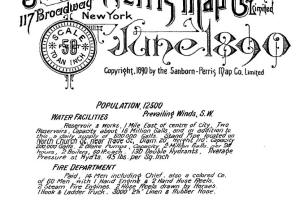
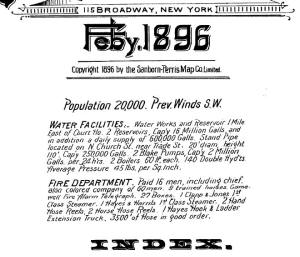
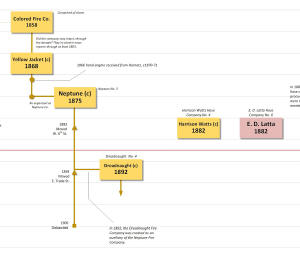
Except of history chart by Mike Legeros. See
original.
top
CLINTON
A company of black firefighters represented Clinton at an early convention
but no other information has surfaced.
CONCORD
Concord Hook and Ladder
Photo courtesy
of North Carolina
Department of Archives N76 6
48
As mentioned earlier without a water supply a fire department is handicapped.
In the year 1897 the water system of Concord was owned by a private citizen
who held a 25 year contract. An elevated tank on Main St. held 130,000 gallons
of water when full. The water level was maintained by two pumps able to pump
800,000 gallons in twenty four hours between them. The population of the
town was 5,000.
The fire department in 1897 consisted of two hose carts with 1,500 feet of
hose and 3 nozzles 5/8 inch. One hook and ladder truck with 12 rubber buckets.
18 men total. How many black firemen at this point is not indicated in the
source.
By 1902 the city was reworking the water system. The hook and ladder company
and a hose company occupied a part of city hall. The hook and ladder company was manned by 30 black men while the other equipment was manned by 24 white
firemen.
Aug. 10, 1911 Concord hosted the convention and tournament of the North Carolina
Colored Volunteer Fireman's Association.
Citations
-
1895 - The Daily Concord Standard
on July 16, 1895, mentioned the "white fire company" and "colored fire
company" as participants in the funeral procession for Mr. John W. Fink.
They're also mentioned in the paper's account on November 4, 1895, of a
barn fire.
-
1895 -
The Daily Charlotte Observer on July 5,
1895, mentioned that the Concord "colored hook and ladder company" had
visited Charlotte and participated in Fourth of July festivities.
-
1898 - The Daily Concord Standard
on June 27, 1898, mentioned both the white and colored fire companies as
having fought the town's largest fire in about fifteen years, that
started in the livery stables of M. J. Corl and spread to other buildings.
-
1905 - The Concord H. and L. Company is listed in
the 1905 conference proceedings.
-
1923 - The Concord Hook & Ladder Company is listed in
the annual conference proceedings.
top
DURHAM

Excelsior
Hook and Ladder Company
Bart
Barber is foreman and holds the trumpet of his office under his left arm.
With no real solid evidence to the contrary the Excelsior hook and ladder
company was formed some time in the mid-eighteen eighties. An article in"
The Tobacco Plant" reads "Mr. Samuel Thaxton desires to return thanks to
the citizens of Durham, both white and colored, for their effort last Friday
to save his residence from fire." This is dated March 17, 1881. The meetings
of the Hook and Ladder Company were held the 1st Wednesday in the Mayor's
office. The first documented foreman was Peyton Smith who operated a grocery
store on Peabody St. He remained foreman for several years and later moved
his grocery to the down town area on West Main street. The Tobacco Plant
published an article November 17, 1887, praising the" colored hook and ladder
company" for their timely efforts at a resent fire. They were sure to have
been organized even before that but this is the earliest record found to
this date.
The hook and ladder wagon was hand drawn in the beginning, with an unknown
number of members, but was later about 16 or 18 men. In the month of January,
1894, the mayor gave a reception for them. Several of the leading white citizens
as well as the fire chief, delivered speeches heaping praise on the company
for the fine work they were doing. A promise was made to get horses for the
wagon. The promise was made good and they soon had a pair of fine black horses
named Frank and Bill and a stable on West Main Street to house the wagon.
The demands for service increased and the two white companies were up grading
their equipment as well. The new fire station was built to house the #1 hose
company and a need arose for more horses. The horses for the hook and ladder
company were replaced by two mules named Rhoddy and Molly. Frank and Bill
were moved to the No.2 hose wagon. Frank died some time later and a proper
mate for Bill was never found he became one of the most famous horses in
the state attending a number of conventions and tournaments of the white
firemen. Capt. Turner, while relating stories about the early fire department
remarked that the mules were no trouble to start when the driver stepped
on the gong, but they were hard to stop. They didn't stay long and horses
were again assigned to the hook and ladder. A pair of dark brown horses named
Bill and Bob took the place of the mules. They served the company well until
early one morning, while answering an alarm in the northern part of the town,
Bob fell dead at the corner of Main and Roxboro.
Robert Ruffin, a black man, apparently had a way with horses for he became
a member of hose company No.2, a white company, as a paid hostler. He went
along with the white firemen to the state tournament and convention in Wilmington
to care for Bill and Dixie. Dixie had torn a hoof in a practice run a few
days earlier and needed special attention. A photograph taken in front of
No.2 station in 1903 shows a black fire fighter in the seat of the steamer.
This man is believed to be Robert Ruffin.


The same steam engine almost a century later
now stand deteriorating in storage.
The city fathers had a hard time in their minds of letting good horse flesh
stand idle. There was always someone trying to find a job for the horses
when they were not actively pulling fire equipment. From time to time the
horses were assigned to pull the sprinkler for wetting the streets to keep
the dust down, or to some other duty. On one occasion when the horses were
occupied an alarm of fire was sounded at a location more than a half mile
from the station of the hook and ladder. Being very strong men the firemen
pulled the wagon by hand the full distance. While reporting on an accident
one of the local papers gave the weight of the wagon to be over two tons.
Accidents were common to both men and horses, some serious. On one occasion
the hook and ladder was making a run down Main St. when fireman John Burnett
attempted to get on the moving wagon. He lost his grip and was thrown to
the ground with such force as to be rendered unconscious. It was first felt
the injury was serious but after being taken to his home and placed in bed
he regained consciousness and was fully recovered the next day. An almost
identical accident involving one of the white firemen, Patrick Farthing was
a little more serious. He was attempting to board the moving wagon and was
being helped up by one of the black firefighters pulling at his shirt. the
shirt tore and his grip failed throwing him under the wheel of the wagon,
he was in a coma for about two days and it was feared that his foot was so
damaged it would have to be amputated, however, he did recover.
Physical condition of these early fire fighters was superb due to the heavy
labor most of them were involved in. A fire alarm in East Durham one afternoon
drew the attention of Peyton Smith and Mack Lyon. Without hesitation they
started running. They ran for a distance of more than a mile and arrived
in time to assist in fighting the fire.
Excelsior, sponsored the tournament and convention of the Volunteer Fireman's
Association in 1894 and again in 1907. Huge crowds attended and a great time
was had by all. They loved a parade and were eager to join in for the open
house celebrations on May 10th each year for the police and fire departments.
It is rather ironic that the last parade they participated in was a celebration
for the confederate veterans in 1912. Durham had gone to a paid fire department
in March of 1909 and in 1912 the city purchased a building in back of the
No. 1 station. Four hundred and eighty seven dollars was spent to raise the
building high enough to accommodate the hook and ladder company. The hook
and ladder company moved to the new station and was manned by white firemen.
February 1913 found a delegation of black citizens with a petition, before
the city fathers making a request for a retired hose wagon to be donated
and used in Hayti, using black firemen. The request was referred to committee
which reported back that a suitable lot for a fire station could not be found
and the matter was never heard from again.
Finch Bumpass had
replaced Payton Smith as foreman and was later replaced by Bart Barbee. Bart
Barbee's photograph was identified by his grandson who remembered his uniform
to be green with a black border. He was foreman of a crew of the water company
and was paid seventy five cents a week extra to be a foreman of the fire
company. The rest of the men of the water company that were also firemen
were paid fifty cents a week extra. Several of the early firemen were freed
slaves. Finch Bumpass died in August of 1912. Bart Barbee the last foreman
was born February 25, 1856 nine years before emancipation and died September
20,1940 just eighteen years before the next black fire fighters were hired
October 1958.

The grave marker for Bart Barbee is located in Cemetery, Durham,
N.C. and the faint image of a trumpet can be seen on both sides of the name.
Photo by Chuck Milligan
Citations:
- 1888 - The Daily Tobacco Plant on October 10, 1888, reported on the
Durham Exposition parade, which included the Colored Fire Company
following the Dick Blacknall Hose Company and hose carriage.
- 1889 - The Tobacco Plant on May 4, 1889, reported on last night's
meeting of the Board of Town Commissioners, and their recommendation
that the "incoming Board" purchase a hook and ladder truck for the
colored fire company.
- 1893 - The Durham Globe on April 6, 1893, identified Peyton Smith as
the foreman of Excelsior Fire Company No. 1.
- 1893 - The Durham Globe on April 13, 1893, printed a letter of
thanks to the Hook and Ladder Company, addressed to Peyton H. Smith,
Esq., Chief Colored Fire Department," from J. S. Manning and in
appreciation for the "good services last night and at such an
inconvenient hour and distance in preventing the destruction of my
property by fire."
- 1905 - Excelsior Horse H. and L. Company listed in
1905 conference proceedings.
Career-Era
Black career firefighters were proposed as early as 1949. "Council safety committee recommends that Negro personnel be trained as firemen"Âť was the title of a Durham Morning Herald story on July 22, 1949. Reported the paper on July 29, City Council deferred that action. But approved motion to
"augment Negro personnel on police force."Âť
Eight black firefighters hired in October 1958. They were George Washington
King, Walter Thomas, Elgin Johnson, Velton Thompson, Robert Medlyn, John O.
Lyon, Nathaniel Thompson, Sylvester Hall, Thomas Harris and Linwood Howard. They
staffed a newly built Station 4 at Fayetteville and Pekoe Streets. The station
opened October 1, 1958, and served predominately black Hayti neighborhoods. The
company used "hand me down" equipment, including an older engine. By 1969, the
entire Durham Fire Department was integrated, and the now ten members of Engine
4 were working at fire stations throughout Durham.
top
EAST SPENCER
East Spencer is a young town compared to most cities in North Carolina. The
modern counter part would be called a bed room community. East Spencer is
where it is because of Spencer. Spencer sprung up almost over night as a
result of the Southern Railroad Shops being built here. It all began just
prior to 1900. East Spencer became the town across the tracks. The white
fire company of Spencer had already made a name for its self by winning races
in the state tournaments and being invited to the worlds fair in St. Louis.
When water lines were installed in East Spencer in 1910 Bob Jones and C.A.
Sides organized a fire department with Jones as Chief and Sides as assistant.
They were not ready to take a back seat to the folks across the track, and
became the team to reckon with at the state tournaments, bringing home prize
money from the annual events, with record breaking times for the grab reel
contest. In 1928 they broke the world record for the grab reel contest with
16 1/5 seconds and two years later set a new record of 16 seconds flat. After
getting the white fire company established in 1911, Jones and Sides helped
L.L. Iddings organize an all black reel company.
By 1913 the white company
had 19 members and black company 17 men each manning a two wheel hand drawn
hose reel with 550 feet of 2 1/2 " hose. The population of East Spencer at
this time was about 3,000. Two miles of water main of 4" to 6" size supplied
40 hydrants, the water coming from near by Salisbury. The White Rose reel
company of East Spencer was soon established as one of the teams to beat
at the annual tournament of the North Carolina Colored Volunteer Firemen's
Association. They too brought home a number of prizes. They earned their
reputation through hard work and many hours of training. Each evening in
the cooler days they could be found "running the reels". This was an activity
that the whole community took interest in. Children gathered to watch the
firemen as they ran their drills over and over. What a great place for a
child to grow up. The firemen not only set a good example in their work at
the train shops but in their civic duties as well. East Spencer hosted the
tournaments on several occasions finding room for the visiting firemen in
their homes. Mack Jones of Oxford smiled as he talked of going to" Spencer"
for the meetings, it was easy to know this was one of his favorite towns.
By the end of 1930 the white fire company consisted of a chief, an assistant
chief, a captain and 20 men all part paid with two fire stations and one
unpaid volunteer, while the colored organization had an assistant chief and
two men who were part paid and 13 volunteers with no pay. The white fire
companies had a Dodge purchased in 1924 and a model T Ford truck. The black
fire company was still running the hand reel from station number three. The
annual meetings of the firemen and later the ladies auxiliary was an event
they all looked forward to. Mrs. Abernathy recalls that one of her neighbors
purchased a new yellow Cadillac to drive to the 1977 meeting "down east".
Just a few of the members of later years that Mrs. Abernathy could recall
were, Sylvester Holmes, Sylvester Turner, Sam Witherspoon, Robert Washington
and of course James Abernathy her husband.
There is some talk of organizing the reel teams again. What a great sport
this would be, and what a great example for the young children to once again
watch the firemen train with the reels. Could it be the sport of the future? THE
RUNNING OF THE REELS.
Citations
- 1912 - The Salisbury Evening Post of July 31, 1912, reported that
Bradley Hargrave, a member of the East Spencer colored fire company, was
badly injured "at fire practice," when the nozzle "slipped from his hand and
struck him in the forehead." He sustained a "dangerous wound" and was
unconscious for a period of time. "He is improving and will recover."
- 1923 - The colored fire company was listed in the 1923 conference proceedings.
top
EDENTON

Courtesy of North
Carolina Department of Archives N 68 10 63
This photo of the Edenton Hose Company may have been made between 1910 and
1920. Documents show a Colored Hook and Ladder company in 1920 with
8 men. The photo above is of a hose wagon. In 1910 there were three hose
reels and a hook and ladder wagon with three companies of eight men in each
company. In 1898 the only fire equipment listed was a hand Hook and Ladder
wagon. With no other equipment listed its is likely buckets were carried
on this wagon.
Citations:
- 1900 - The Fisherman and Farmer on October 25, 1900, reported "the new hook
and ladder carriage for the colored fire company of this city has
arrived and is quite an improvement to our fire department."
- 1905 - Phoenix H. and L. Company listed in
1905 conference proceedings.
- 1920 - Sanborn Maps from August 1920 maps describe the fire department as
"Volunteer. Three companies of eight men each. Three hose reel carts with
300 feet 2 1/2-inch hose on each. One supply cart with 250 feet 2 1/2-inch
hose. One 40-gallon chemical engine. Colored hook and ladder company with
truck and 60-feet of ladders. Fire alarm by bell at courthouse and whistle
at water works."
- 1927 - Sanborn Maps from January 1927 map describe the fire department
as "Volunteer, one chief and sixteen men, all partly paid." There is one
fire station, a motorized pumper, and hand reel and hook and ladder in
reserve. Earlier maps, from January 1910 and January 1904, list volunteer
firemen, but without information on race.
top
ELIZABETH CITY

Andrew W. Williams
last surviving member of the Quick Step Hook and Ladder Company
The Quick Step Hook and Ladder was organized in 1891. Some twelve years would
pass before a municipal water supply would be established. Quick Step was
an elite group of men who guarded membership in their organization closely.
John Williams was one of the early organizers and some member of his family
has served on the department from the beginning.
Rescue and ventilation was the area of expertise in which they operated.
The capability of demolishing threatened structures was also a part of their
duty and the hooks they used are today in a museum.
After the water system was functional two steam engines were purchased and
manned by white firemen. The hose company was manned by whites as well.
By 1914 fourteen white fire fighters and forty colored men made up the fire
department. The equipment was housed in one building and when the alarm sounded
they all gathered at the same fire house to respond.
Citations
- 1901 - The Weekly Economist on May 10, 1901, reports that the "colored
fire company of this city" will visit the colored Rescue Fire Company of
Norfolk County on June 15.
- 1902 - The Tar Hell on December 12, 1902, reports that the "Rescue
Hook and Ladder Co., composed of the colored citizens are doing
effectual work in fighting fires. At a recent fire they had extinguished the
flames before their white friends had reached the scene of the
conflagration. They deserve the unreserved appreciation of every person in
this city. Elisha Overton the captain is a competent leader and one who
merits confidence."
- 1905 - Excelsior H. and L. Company listed in 1905
conference proceedings.
- 1914 - Sanborn Map of 1914:
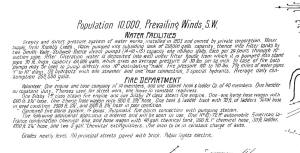
- 1923 - Sanborn Map of 1923:

- 1923 - The Daily Advance on January 17, 1923, reported that "Tuesday
afternoon at 4:55 a.m. an alarm from Box 63 called the [fire] department [to
a home] on Tatum's Lane [for a chimney fire with no damage. It was the first
time the new Quick Step ladder truck had been used.]
- 1923 - The Daily Advance on January 22, 1923, reports that a "house has
just been built back of the engine house for the new hook and ladder truck
which is manned by the Quick Step Hook and Ladder Company, a colored
volunteer firefighting band." The new Brockway/American LaFrance combination
chemical and service ladder truck cost $6,500 and was purchased by the city.
It carried 250 feet of ladders and 40 gallons of chemicals, noted the
newspaper.
- 1924 - The Daily Advance on January 2, 1924, mentioned that the Quick Step Hook and
Ladder Company wanted to express its appreciation to the people of Elizabeth
City, for their generosity which made possible the company's new helmets, rain
coats, and boots, and which would protect them against inclement weather "in the
course of duty during the coming winter."
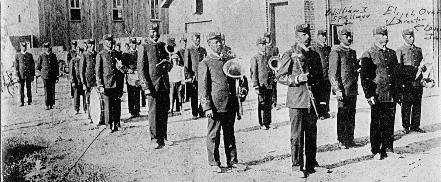
Quick Step Band 1908
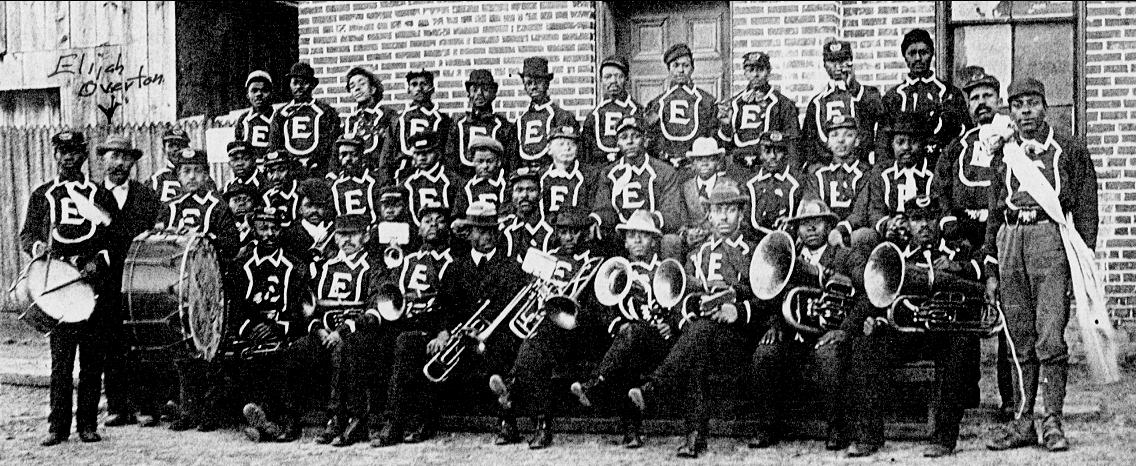
Quick Step Band 1919
The horse drawn hook and ladder was replaced by a solid tire chain drive
Brockway Hook and Ladder about 1921 and this was the first line ladder truck
until 1950. By 1923 the chief was a full paid position and three white drivers
were also paid. There were 22 white volunteers and the black company of 12
volunteers had a paid driver.
As members of the NCCVFA the Quick Step company also maintained a band that
participated at the conventions and tournaments. Not all of the band members
were firemen and in a 1919 photo of the band there are forty-one members.
In 1977 all of the fire companies determined it was time to merge their manpower
and the all black company gave way to an integrated department. One of the
oldest living members of the all black unit stated in an interview that he
felt over the years they had been “treated fairly and squarely”
top
ENFIELD
Citations
- 1909 - Sanborn Map from 1909:
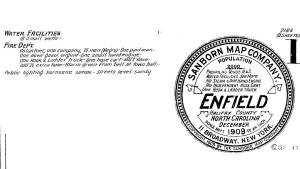
- 1912 - The Progress on August 23, 1912, noted that the
Enfield Colored Fire Company returned home last night from the
annual colored firemen's tournament in Oxford. They did not participate
in any of the games, except the foot race, "because the full company
could not attend." Issac Lowe took second place in the foot race.
- 1915 -
Sanborn Map from 1915:
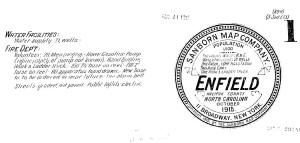
- 1915 - The Progress on August 20, 1915, noted that the town's
colored fire company left Tuesday to attend the annual colored firemen's
convention in Tarboro.
- 1921 -
Sanborn Maps from June 1921 describe the fire department as
consisting of twenty colored volunteers who were paid a nominal salary. The fire
station was located at 124 Main Street and equipment included "one old-style Howe gasoline engine, capacity about 250 gallons per minute, fair condition only. One hand-drawn hose reel with 300 feet of 2 1/2-inch hose. One hook and ladder truck with 25-foot extension ladder."
The fire alarm was sounded by factory whistle and telephone.
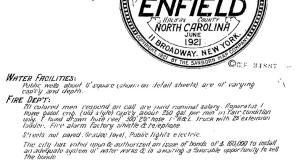
- 1922 - The Progress on August 25, 1922, reported that Enfield's fire
company "made a most excellent showing" at the annual colored fire
company tournament in Tarboro, and took second and third place in the
first three contests. It added that Enfield has "no water with which to
practice, and the other towns and cities having water works, it must be
admitted that we have one of the best companies in the state."
- 1923 - The Gas Engine Fire Company is listed in the 1923 conference
minutes, with a Foreman, Secretary, Treasurer, and 26 members.

Some of the delegates to the 1961 convention on the North Carolina Volunteer
Fireman's Association in Enfield, N.C.
Shown above, left to right front row. Robert
Coleman, Warrenton, Cleveland Anderson, Warrenton, L.R. Barnes., Greenville,
Luther Tuck, Wake Forest, D. A. Willis, Oxford, on the right end James
Plummer, Warrenton. Back Row left to right John Bizzel, Greenville,
McCarroll Alston Warrenton, O.C. Smith, Wake forest, L.H. Hall, Salisbury.
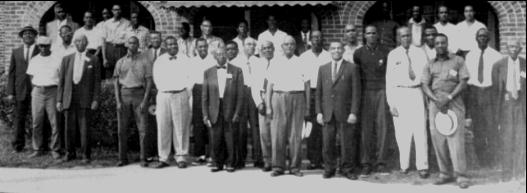
Other delegates Enfield 1961
Photos by Kilebrew Studios Rocky Mount, Courtesy Charles Kilebrew
Top
FARMVILLE
Farmville and the other cities in the coastal plain maintained their black
firefighters much longer than did the departments in the Piedmont and the
Mountains. Farmville has never been a large industrial city but has
always had an active fire department. The black fire company there
consisted of 12 men but they were able to host the convention and tournament
in the 30s. The history of this company has been preserved and will
be updated in the future.
Citations:
- 1915 - The Farmville Enterprise on April 2, 1915, reported that the
town now had a fully equipped fire department comprised of four
companies: three hose companies and one hook and ladder company. Company
Number 3 was colored, and led by Captain Sherrod Blount.
- 1937 - The Farmville Enterprise on August 20, 1937, reported that
200 colored firemen, comprising 12 companies and representing 18 towns,
held the 47th annual convention of the "North Carolina Negro Volunteer
Fire Association" in town that week. Members of Farmville's colored fire
company were listed as Joe Askew (Captain), Walter Bullock, Leon
Wallace, Starlin Gorham, Red Dupree, Ed Joyner, Bennet Gorham, William
Baker, Shaw Blount, Ernest Moore, Jack Hopkins, and Tom McKenney.
- 1940 - The Farmville Enterprise on September 20, 1940, reported that
the "colored fire department" would stage the Pitt County Colored Fair
that year.
- 1943 - The Farmville Enterprise on March 26, 1943, reported on
meeting of the town's black citizens, on the subject of civilian
defense, and that the "Negro fire company" was fully present.
Sanborn Maps:
- September 1915
Volunteer, three hose companies with fifteen white and twelve "negro men." One
hook and ladder company of four men. Three reels and 1500 feet
two-and-a-half-inch hose. One hand-drawn hook and ladder truck. Fire alarm bell.
Twenty-five double hydrants.
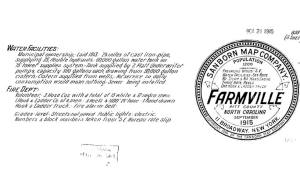
- April 1923
Volunteer, thirty-two, one paid driver, one paid chief. Department fully
motorized. Gamewell electric fire alarm system. Thirteen boxes. Alarm direct to
power plant whistle. Fifteen call boxes "in transit" to be installed by May 15,
1923. Will transmit alarm directly from boxes. Also, one sixteen-inch mechanical
gong to be installed on Wilson and Main Streets. Fifty-five double hydrants.
Station 1 with twenty men (volunteers). Triple combination American LaFrance
pump, chemical, and hose car. 750 GPM pump capacity. 60 gallon chemical
extinguisher and 1000 feet two-and-a-half-inch C.R.L. hose (new). 1000 feet
two-and-a-half-inch C.R.L. hose in reserve (good condition).
Station 2 with twelve men (colored volunteers). One Ford hose truck with 1000
feet four-inch C.R.L. hose, 1000 feet C.R.L. hose in reserve (good condition).
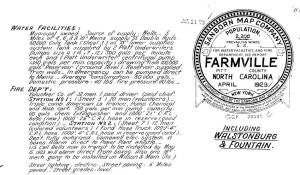
- May 1929
Station 2 has twelve men, colored volunteers, equipped with one Chevrolet truck
with 800 feet two-and-a-half-inch hose.
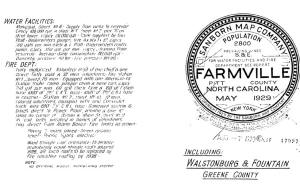
- December 1937
Station 2 has twelve "colored volunteers" and a Chevrolet truck with 800 feet
two-and-a-half inch hose.
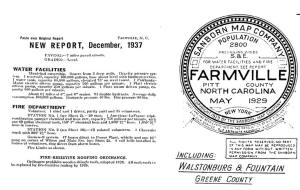
FAYETTEVILLE


Monument dedicated to W D. McNeill, one of the founders and longtime
President of the North Carolina State Fireman's Association.
The Cape Fear river was the center of trade in the early life of Fayetteville.
Paddle Wheelers plied the river as a quick way to move farm products to markets
far away. There was also a lively trade in slaves prior to the War Between
the States. As early as the mid 1700s fire was beginning to be a problem
for this blossoming community. Accounts of whole cities being consumed by
fire led everyone to be ever watchful for anything that could spark a blaze.
The colonist had learned early on that it was everyone's responsibility to
be prepared to give their best effort at the outbreak any fire. The year
1831 was to prove disastrous, a fire almost destroyed the town.
Hand engines were in use in 1847 when authorization was given to purchase
two lots on Gillespie Street on which to build an engine house. On June 24th
,1848, the commanding officers of the two engine companies and the hook and
ladder company were permitted to enlist twenty five black men in each company
to work the engines. and to help with the ladders. They were to be given
proper hats or caps at public expense, to show which company they belong
to. Their owners had to give permission for them to serve and the firemen
were to be compensated at the judgment of the Chief Fire Warden.
Citations
- 1866 - The Weekly Progress of Raleigh on January 6, 1866, reported on a
celebration in Fayetteville on January 1, that included participation by
the "negro fire company."
- 1873 - The Statesman on April 19, 1873, said in an editorial that the
"head of one of the fire companies of Fayetteville" says the town's fire
engine isn't in use, but "could be made useful with repairs." He also
believes a colored fire company should be created, as "he knows from
experience that the colored men work better at fires than white men." They
hoped that the next board of Mayor and Commissioners "will take the subject
under consideration, and do all in the power of the town to encourage the
formation of a colored fire company in y our town. Don't run politics in
your fire companies!"
By December, 1884 the black firefighters had become well established and
operated the two hand engines. The white firefighters manned the hook and
ladder truck and the bucket company. Reservoirs or cisterns were dug in several
areas of the city and pipes laid to connect them, hydrants were also installed
at each location. A Silsby Steam Engine had been acquired and a Silsby pump
ran by a turbine furnished water to the mains and hydrants. The choice of
using a stream straight from the hydrant or using the hydrant to keep the
reservoir filled was made by the first arriving unit. The steamer would draft
from the reservoir.
The black fire company distinguished themselves for a number of years attending
the state conventions and tournaments.
Citations
- 1923 - The Fayetteville H. R. Company is listed in the
1923 conference proceedings.
In 1947 C.R. Miller was serving as
president of the North Carolina Colored Volunteer Fireman's Association.
Fayetteville opted to form a paid fire department in this year. The plans
for a paid department did not include black firefighters. C.R. Miller, along
with seven other black firefighters wrote a letter to the fire committee
which is reproduced below. As a result of this letter the black fire company
was given $150.00 a year to continue training Accounts of the demise of the
black fire company have yet to be found, they apparently faded away with
out notice.
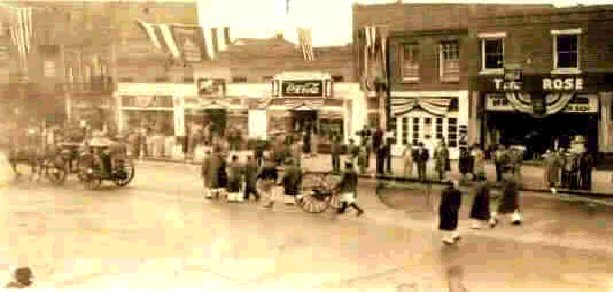
Black fire fighters on parade probably in Fayetteville.

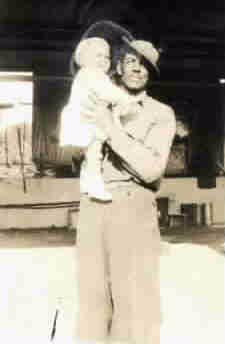
J.W. Archie
Well-Known Negro Is Traffic Victim
The black flag hung from the First Citizens Bank building today as the week-end
produced the first traffic death in Cumberland County in more than two
months.
J.W. "Will" Archie, 66, of 912 Ellis Street, a very well-known Negro resident,
died Sunday afternoon at 5:30 o'clock of injuries sustained when he was struck
late Saturday night on Bragg Boulevard by a car driven by Charles Dawkins,
116 Ruth Street. Archie suffered a fractured leg and a head injury. He had
been employed for years at the incinerator by the City of Fayetteville and
had worked at Breece's Banquet Hall until several months ago. More recently
he had been engaged in the horseshoeing business and had a small shop in
the rear of the Rogers and Breece funeral home on Bow Street. Archie's death
saddened the convention for many of the local firemen as he was an old-time
member of the Fayetteville Volunteer company and recently had been engaged
in shining and getting ready for display the old horse-drawn pumping engine
of the local department. He is the 19th person to die in 1948 as the result
of a traffic accident in Cumberland County. Witnesses to the accident said
Mr. Dawkins was not to blame. He was driving approximately 35 miles per hour
in a line of traffic returning from the baseball game when Archie is said
to have stepped in front of the car while attempting to cross Bragg Boulevard
near the Ames Street intersection.
Statements absolving Mr. Dawkins were
made to the investigating police by I.B. Julian, E.B. Bates and W.D. Hyman.
Coroner J.W. Pinkston said an inquest would not be necessary. Archie was
the first person to lose his life in a traffic accident since the current
safety campaign was started. The last previous fatal traffic accident occurred
June 6. Archie is survived by one son, John William Archie, Jr.; by one daughter,
Laura Williams of Rock Hill, S.C.; by four brothers, Charlie Archie of
Winston-Salem, James Archie of Greensboro, Henry Archie of Baltimore and
Hope Archie of Vandermere, N.C.; by three grandchildren and number of niece
and nephews. He came to Fayetteville 50 years ago from Winston-Salem and
for years was employed at the C.L. Bevill stable where the courthouse now
stands. When the stables were removed, he became a popular drayman and driver
for the Fayetteville fire department. As a fireman he trained under the late
Capt. James McNeill. When trucks replaced fire horses, he was employed by
the city sanitary department and was in charge of the abattoir and incinerator.
After his retirement he was employed at Breece's Landing. He was a faithful
member of Evans Metropolitan A.M.E. Zion church, a member of the board of
stewards, the usher board and the Boy Scout committee. Funeral services will
be conducted Thursday afternoon at 5 o'clock from that church and Rev. D.I.W.
McInnis and burial will be in Cross Creek cemetery.
Active pallbearers will be Baker Plummer and Harvey Brown of Warrenton, Julian
Lyon of Enfield, Charles Monroe, Jim McLean, B.C. Morgan, Cicero Miller and
Sam Drake, all of Fayetteville. Honorary pallbearers will be members of the
Fayetteville Volunteer Fire Department, both white and colored, and members
of the paid fire department.
The Fayetteville Observer
Monday, August 9, 1948 Page 1
Editor's Note: Although the above article listed Archie as G.W. Archie, he
is listed as John William Archie Sr. in the County Vital Records. He was
the son of John W. Archie.
This obituary was contributed by Daisy Maxwell, Librarian of The Fayetteville
Observer.
top
GASTONIA
From History of the Gastonia Fire Department by Robert L. Ridgeway,
Former Fire Chief, via
https://www.cityofgastonia.com/images/files/fire/documents/GFD_Fire_Department_History2-12-15.pdf
By 1900, [...] the Board of Aldermen began to
seriously consider the formation of fire companies to provide formalized
fire protection for the town's citizens. Gastonia now had six cotton mills,
a third hotel, and an opera house. In recognition of the growing threat of
fire, town Aldermen passed a motion on December 6, 1900 to allow Negroes to
organize a fire company of 12 members, to relieve them of the poll tax, and
to give each member a shirt and a cap . This action was followed on February
7, 1901 by the acceptance of an application for the formation of a white
volunteer fire company , and equipment for 5 of their number was ordered to
be purchased .
During 1901, the Board of Aldermen continued with
efforts to add to and formalize fire protection in Gastonia. On May 23,
1901, a permit was issued allowing Anders and Floyd to erect a wooden shed
adjoining the stable now occupied by them and situated within the fire
limits of the Town of Gastonia . On June 6, a motion was passed that
authorized T.L. Craig to buy for the town two mules, harnesses, and a
wagon, the kind of wagon, harnesses and mules to be determined by Mr.
Craig . Thus, by the end of 1901, Gastonia had formalized the organization
of fire companies and purchased its first fire engine.
On May 16, 1902, the Mayor appointed V.E. Long and
J.L. Robinson to serve as a committee to investigate the needs of the
fledgling fire department, and to make a report back to the Board of
Aldermen. The committee was authorized to purchase such hose, suits,
nozzles, and such as per list submitted . On June 12, it was moved and
seconded that we erect an ordinance creating a Chief of the Fire
Department . On September 11, 1902 the committee recommended that a fire
chief be elected, and that we elect George Glenn Chief of the Fire
Department . This motion was passed, and the Gastonia Fire 3 Department has
its first chief.
On April 11, 1904, W.P. Upton succeeded George Glenn
as Fire Chief, at a salary of $ 100. per year, while other members of the
volunteer fire company were paid $ 20. per year. A major organizational
change in the fire department occurred at this time by combining both the
white and the colored volunteer fire companies under the control of one
chief. As noted in the minutes of the Board of Aldermen meeting on April 11,
1904: the colored men were to be under the control of Chief Upton and to
get the same pay as the white (men) do .
Demand for service and a general lack of support
apparently doomed the two volunteer fire companies, and the colored Fire
Company was disbanded on October 1, 1906. Aldermen V.E. Long and T.W. Wilson
specified in Town records that the thanks of the Board were extended to the colored firemen for their efficient services . The disbanding of the
colored volunteer Fire Company was followed on July 23, 1907 by the mass
resignation of the volunteer firemen of Hose Company Number One . The
letter of resignation submitted to the Board of Aldermen noted that the
volunteer firemen have not had the proper support and funding from the Board
of Aldermen that a volunteer fire company should receive . Apparently the
mass resignations and complaints of the volunteer firemen served to good
purpose, because another volunteer fire company was immediately organized by
the Board as Gastonia Fire Company Number One, and B.H. Parker was elected
as Chief.
top
GOLDSBORO
Goldsboro is still
in question.
Citations of colored firefighters in
Goldsboro are hard to find. The Raleigh Observer on July 16, 1879, noted
that colored firemen from Charlotte, Warrenton, and Goldsboro were expected
to arrive that day, to meet the colored firemen of Raleigh and participate
in a "grand festival."
The Goldsboro Daily Argus on September 7, 1898, reported that
the Board of Aldermen the night before discussed the report of a committee
looking "into the matter" of organizing [another?] colored fire company. The
committee's report was "unfavorable" and the topic was "carried over till
next meeting."
GREENSBORO

Photo courtesy of Archives Division,
Greensboro Historical Museum
1981.6370
The Charlotte Chronicle newspaper on
November 24, 1887, reported that "a colored Hook and Ladder Company has just
been organized, and the city has offered to equip them with uniforms, etc. They
will be subordinate to the white fire department, which is now in splendid
trim."
The Excelsior reel team and possibly at least one other black fire
company served Greensboro for several years. When a newspaper published an
article about modern day black firefighters being the first black firefighters
in Greensboro an older citizen stepped forward to make a correction. Elam
Harper had known these early firefighters from the beginning of their
organization and was quick to set the record straight. Other than the
above photo little has been done to research and preserve the history of this
fire company.
The first career firefighters were hired in 1961. Twenty-eight were hired,
comprising the largest academy of new firefighters in city's history. They
staffed a newly built Station 4 at 401 Gorrell Street. They staffed Engine 4
and a new ladder company, Truck 4. In or after 1966, the entire Greensboro
Fire Department was integrated. On April 12, 1966, the city's Human
Relations Commission presented a plan to City Council to integrate all fire
stations.
Citations
- 1887 - The Greensboro North State on November 24, 1887, reported
that the city commissioners met last Friday night and a resolution
"regarding the colored fire company was adopted." As the city can't
afford to buy a steam fire engine, and they don't feel that the chemical
engine "is either safe or efficient," they recommend that the colored
fire company "organize for the present as a hook and ladder company."
And that the city furnish them "with jackets and other articles
necessary to accomplish this end."
top
GREENVILLE
The first fire company in Greenville,
and in Pitt County, was the colored Rough and Ready fire
company, organized by Captain Samuel Mason in 1884. See biographical
information in the Wilson section.
Citations
- 1896 - Sanborn Maps from May 1896 listed this information about
Greenville:
Fire department - Volunteer - One combination hand fire engine, one hook &
ladder truck, one hose reel 1000 feet 2 1/2-inch hose. Forty [white]
members. Forty colored members with hook & ladder truck.
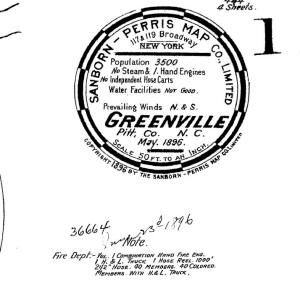
Subsequent maps do not mention race.
- 1898 - The next map, dated March 1898,
lists this information:
Fire department has seventy-two "volunteer men." One LaFrance steam engine,
one hand reel, one hook and ladder truck, one combination chemical and water
hand engine (Howes), and other equipment.
- 1899 -
In 1899, the proceedings of the North Carolina State Firemen's Association
mentioned three colored fire companies operating in Greenville:
Head Hawk Fire Company
Hope Fire Company
Rough and Ready Fire Company.
- 1905 - The Rough and Ready H. and L. Company
is listed in the 1905 conference proceedings.
- 1923 - The R & R company is listed in the 1923
conference proceedings.
top
HENDERSON
Henderson sent two black fire companies to the 1906 convention and tournament
in Winston.
Citations
- 1894 - The Henderson Gold Leaf on August 16, 1894, reported that the
colored fire company of Henderson attended the firemen's tournament in
Durham that week, and won second prize in a contest. The company "carried 19
members" with M. M. Peace as Captain and Lewis H. Hughes as Foreman.
- 1897 - The Henderson Gold Leaf on August 19, 1897, reported on the
annual colored firemen's association convention and tournament in Winston
last week. Henderson's Enterprise Hose Company won first
place in the championship reel race. Participating members were John I.
Rowland (Captain), Lewis H. Hughes (Foreman), Geo. Hughes, Charlie Hughes,
Nathan Brodie, Walter Brodie, Sonny Harris, James Smith, Plummer Turner,
Henderson Wortham, James Stamper, William Cheek, General Cheek, Henry
Hughes, Louis Hodge, and Frank Wimbush. The Red Wasp Hook and Ladder
Company won second prize in its race. Participating were W. H.
Reavis (Captain), J. H. Durham (Foreman), Lunnis Young, Dave Bullock, J. W.
Hart, Sam Peace, Ben Howard, Plummer Hester, Larkin Smight, Rufus Allen, D.
H. Corzart, and Henry Hawkins.
- 1899 - The Henderson Gold Leaf on August 10, 1899, reported on the
annual colored firemen's association meeting in Washington. The
Enterprise Hose Company attended, with Nathan Artis (Captain) and
Will Howell (Assistant Captain) mentioned. Also the Red Wasp Hook
and Ladder Company attended, with Haywood Reavis (Captain) and
Henry Durham (Foreman) mentioned.
- 1904 - The Raleigh News & Observer on August 12, 1904, reported that a colored fire company from
Henderson called Enterprise attended the 1904 convention.
- 1905 - The Joint H. R. No. 1 Company and the
Enterprise H. R. No. 2 Company are listed in the 1905
conference proceedings.
- 1909 - The Henderson Gold Leaf on January 14, 1909, printed a list of
municipal expenses for the last six months, which included mention of
Enterprise Hose Company and Joint Hose Company No.2,
for "expense to Rocky Mount" [for convention and tournament?].
LINCOLNTON
There is no question that Lincolnton had a black fire company for a number
of years but that information is not available at this time.
The Lincoln Courier on January 3, 1890, mentioned the work of the colored
fire company, in battling a blaze at the store named the Racket, described as
"one of the most thriving, most popular, and most enterprising businesses of our
town." The fire started in the basement and could not be extinguished, but the
fire company and citizens prevented its spread to adjoining buildings.
Citations
- 1893 - The Lincoln Courier on May 26, 1893, reported that the town "has
a first rate hand power fire engine. Some of the colored citizens are
anxious to reorganize a fire company. They say if the citizens will purchase
for them a uniform they will get up a good company. We are inclined to
believe that they ought to be encouraged to form such an organization." No
further citations have been found.
- 1908 - The Lincoln County News on November 13, 1908, reported that the
presumably white Lincolnton Fire Company was organized that week.
top
LOUISBURG

The story of Louisburg is a bit unusual as there was only one piece of equipment
available and both black and white firefighters rode the same piece of equipment
as volunteers for several years in the first part of the 20th
century.
The history of Louisburg's colored fire company has been
researched and documented by Al Peoples and Larry Peoples, in their book The
Louisburg Fire Department: A History, self-published in 2012.
The company was originally named the Louisburg Hose and Reel Company and also called the Louisburg Colored Fire Company and the Louisburg Colored Fire Department.
It was formed in 1931 and operated as a "separate unit of the Louisburg
Fire Department." The company held "their own monthly business and dinner
meetings," originally at the Lodge Hall on West River Road and in later years at
Otha Wilson's Automotive Repair Shop on Bunn Road. In those later years, Mr.
Wilson was the captain of the colored fire company.
Though the company did some of their own training, most of their training was
"in conjunction with the main fire department." The company joined the other
firemen at the fire station, and "the groups participated together in whatever
training was provided."
In the "early days," the company lacked the same equipment as the "main
department." They didn't have the same quality of turnout gear, or a "telephone
or pager alarm system." Through the years, however, their equipment improved and
"ultimately every fireman in the department was equally equipped."
The colored fire company operated independently administratively, but when
responding to fire calls, "all of the fireman worked together, supported each
other, and did the best possible job of protecting the lives and property of the
citizens of Louisburg."
On August 4, 1931, the first discussion of a colored fire company was recorded
in the minutes of the town council. Fire Chief J. S. Howell "suggested to the
Board that a Colored Fire Company be organized with headquarters in South
Louisburg. [He] stated that this would not only be a great assistance to the
Louisburg Fire Department, but it would possibly lower the fire insurance rates
[in town] [and by] and amount greater than the cost of the upkeep of a Colored
Reel Team." Chief Howell was instructed by the council to "thoroughly
investigate the above proposal and present an estimate of the expenses of a
Colored Fire Company" at a future meeting.
On August 10, 1931, the Franklin Times reported that the fire company
had been officially organized. "A colored reel team, as an auxiliary to the
Louisburg Fire Department, was organized by Chief J. S. Howell, on Monday night
[August 10] with the following members: R. M. Williams, John King, Harry Hill,
Walter Murray, Ed Gill, Thomas Williams, Willie Harris, John Henry Stallings,
Jack Hayes, and Morris Brown. This company will be equipped at an early date
with reel and hose and other necessary equipment and [be] stationed on the south
side of the Tar River. A more complete organization awaits the return of the
members and deletes of the fire department from the Firemen's Tournament [and
convention] to be held at Tarboro beginning August 18."
The location of the fire company was likely the "hose storage station" on
Kenmoor Avenue shown on Sanborn Insurance Maps in 1922. That year, the map
describe the fire department as having one American LaFrance triple combination
motor truck, 750 GPM, 40 gallon chemical tank, and 1500 feet two-and-a-half inch
hose. Plus 1000 feet of hose in reserve. Plus 500 feet of hose on a hand reel on
Kenmoor Avenue. The fire alarm was a siren on a Market Street Building. The town
had thirty-seven double hydrants.
The map of 1930 shows the fire station at 317 Bull Run Alley, at the south end
of Market Street. The two-story building was located beside the jail.
The next mention in the town minutes of the fire company was at the August 6,
1931, meeting. The Town Council was requested to pay for the dues, so the
company could become members of the "State Colored Fire Association." The
board's clerk was instructed to pay $7.50 to the secretary of the state
association.
On April 5, 1932, the colored fire company responded to a fire in the rear of
home of Mrs. Pattie Pittman on east Nash Street. They found a pile of trash
ablaze. The account was reported in the Franklin Times, and noted that
the fire company was "stationed on South Main Street."
During the September 5, 1941, meeting of the town council, the following motion
was made: "That the Colored Fire Company be given the [National Guard]
auditorium free of charge, for the purpose of holding a dance for the benefit of
the Colored Fire Company." The proceeds of this event were not mentioned, but
likely to be used to "purchase turnout gear or other equipment."
On November 5, 1965, the Fire Chief and Mr. Robert Lee Harris appeared before
the town council, to discuss equipment for the fire company. The motion was
carried that the Town Administrator investigate the "cost of twelve coats."
Minutes of the town council also showed that money typically appropriated each
year, so the company could send delegates to the state convention. This is
documented for most years from 1931 until 1966, the year that the colored fire
company merged with the "main department."
The colored fire company twice played host to the state organization's annual
convention. The event was held in Louisburg in 1963 and again in the mid-1980s.
On October 6, 1986, the Louisburg Fire Department and the Louisburg Colored Fire
Department were merged. At a fire department meeting on that date, "a motion was
made and passed to consolidate the black and white companies into one company."
The change was effective immediately, and both groups would "have their dinner
and business meeting together at the next monthly meeting."
top
KINSTON
The first fire company in Kinston was the colored Dread Not
(Dreadnaught) fire company, organized by Captain Samuel Mason
in 1896. See biographical information in the Wilson section.
The colored Hook and Ladder Company served the city of Kinston by 1916. It was mentioned in a newspaper article in the Raleigh Times, July 15, 1916.
top
MONROE

Photo by Chuck Milligan
The McShane foundry must have been one of the few bell makers
on the east coast. This bell and several others of the same style hang as
a lasting memory of the times when this was the clarion that rousted fire
fighters from their warm beds to face the red demon and the elements.
News accounts from Monroe are almost non existent. Information about their
black fire fighters has all but disappeared. One account in recent years
from The Enquirer-Journal, Wednesday, February 25, 1976 featured James Blount
as the last surviving black fire fighter. It was a brief article but did
name others who had served.
The Charlotte Observer on July 5, 1889,
mentioned that the "colored fire company Monroe" traveled to Charlotte to
celebrate the Fourth of July, and joined Charlotte's colored fire companies in a
"street parade." They also engaged in a contest with the "running teams Nos. 1
and 2" of the Neptune Company, competing in the quickest time for stretching
hose and flowing water from a hydrant.
The earliest documents are from the council minutes of April 4, 1898. The
Council approved the purchase of a bucket, a dipper and an oil can for the
colored fire department. The purpose of the bucket and dipper are not stated
but this was a common item in most households in this era and was used for
drinking water. A common dipper for all occupants and visitors to drink from.
The Charlotte Observer on August 8, 1901,
mentioned that the "colored reel team" was practicing nightly for the "coming
contests" in town.
In 1902 Monroe had 35 white firemen and 25 black. The black company manned
a Hook and Ladder Wagon. By 1914 the number had not changed while records
for 1922 show the number down to 12 men and probably still manning the Hook
and Ladder.
The convention of the North Carolina Colored Volunteer Firemen's Association
held in Monroe in August, 1901.
In 1905, the Monroe H. R. No. 1 company was listed in the
annual conference proceedings. In 1923, the Monroe Hook & Ladder Company
No. 2 was listed in the annual conference proceedings.
[The convention was also held in Monroe on] August 20, 1929. The 1936 convention
was held in Wilmington, this was the last meeting attended by the Monroe
fire fighters. From the information developed it appears the fire company
served Monroe for a period of about 38 years.
A list of names of black firefighters having served Monroe are included in
the appendix. There are as many as ninety names listed. The compiler of the
list also gave the occupation of each of the members. This included a number
of mill workers, several railroad workers, barbers, an undertaker, a store
owner as well as a number of city employees. The occupations were diverse
but they had a common unity in their desire to serve the community, spending
countless hours of their "free" time practicing on Lancaster Street. The
location was between two schools where a fire hydrant was convenient.
[ Newspaper Account ]
Monroe won the bid for the convention for 1929. The economy was still good
and the crash was coming in the near future but no one knew this at this
time. This would be a great event for the city and for the fire fighters.
Arrangements were made for 350 visitors to stay in private homes. A number
of cities had lost their black fire fighters such as , Charlotte, Durham,
Greensboro, Wilmington and Raleigh. The requirement for lodging had been
greater in earlier years.
As in the past the convention was to be held in August. This year it was
to begin on Tuesday August 20. The traditional parade was to" form Wednesday
morning on Winchester Ave. at the High School. From this point it would go
to the Oil Mill, follow that to Highway 20, and by Charles St. to Houston,
thence to Church . Up Church Street to Jefferson , thence around the square
and to the C.M.E. Church. "
The races were to be held on Wednesday and Thursday with the singing contest
on Wednesday night. An admission charge of twenty five cents was charged
for the singing. Quartets were billed from Concord, Wilson, Winston-Salem,
Farmville, East Spencer, Enfield, Statesville, Tarboro, Oxford, Greenville
and Monroe.
The opening session was held at The Mount Calvary A.M.E. Zion Church on Tuesday
evening, August 20, 1929. There was singing, speaking, more music and more
speeches. The State Fire Marshall , Sherwood Brockwell addressed the group,
The Mayor spoke the Fire Chief G.B. Caldwell spoke they took up a collection
and they prayed. This was a well planned event. Prof. J.N. Brown served as
Master of Ceremony.
The Parade was a huge success and was over a mile long. Fire fighting equipment,
floats and decorated automobiles along with bands made up the procession.
All of the officers were re-elected with Colonel C.S.L.A. Taylor of Charlotte
remaining president.
Herman Cunningham was a very valuable resource in Monroe.
top
MOREHEAD CITY
The neighboring town of Beaufort had organized a fire department consisting of
both black and white firemen. As time for organizing a fire department arrived
in Morehead City a call went out for volunteers both black and white to come
together for that purpose. For some unknown reason the black community did not
respond. Some time before this an unusual event occurred that merits inclusion
in this document.
On May 18, 1906, the town commissioners passed a
resolution to purchase a new fire engine and fire equipment. Upon delivery of
the hand-drawn gasoline-powered Howe engine, Mayor C. S. Wallace was
instructed to organize both a white and colored fire department. The colored
citizens never organized, but the white citizens organized a fire department
within a few months. Source: Pictorial History of Morehead City, 1714-1981,
Terrydale Printing Company, Greenville, NC, 1982.
NEW BERNE
The second oldest city in North Carolina would be expected to have a rich
history, and it does. The native Indians favored the area of the confluence
of the Trent and Neuse rivers for hunting and fishing. The Iraqis traveled
each year from near the Canadian border to meet other groups at this favorite
spot. Is it any wonder that when the white man arrived he could not resist
this same area for these reasons.
Lawsons Journal, was a source of encouragement to many to try to make their
fortune in the fertile soil around New Berne. Of course the contest for
possession of the virgin land was won by the white invaders either by deception
or by force. Christoph Von Graffenried is considered to be the founder of
New Bern. There were others that came before his group but it was his intent
to establish a town and he did. Graffenried was a compassionate and forthright
person who attempted to treat the Indians fairly. Should all of these early
colonist had the respect for the Indians that he did our history would be
completely different. After a great number of lives were lost because of
mans greed and disrespect for one another the town was finally established.
At one point the colony was at the point of starvation. Graffenried had exhausted
most of his funds but continued to care for the inhabitants. He had left
New Berne in search of supplies to sustain the group. In Bath he was able
to secure enough provisions to tide them over for some time. Among the supplies
was a quantity of tobacco, powder and lead. The crew that was responsible
for the cargo drank a little to much and as a result were not fully alert.
A spark from a stove in the galley of the ship popped out and ignited some
tobacco near by. The crew in fear of the powder exploding abandoned the ship
and its cargo. The fire did reach the powder and all of the provisions were
lost.
At times the Indians would decide they had enough of the white man and go
on the war path. Fire was one of their major weapons during these times as
they burned homes and animal shelters. The Indians were not the only ones
to use fire as a weapon . Graffenried told of a group of English settlers
who once captured an Indian chief and roasted him alive. Graffenried abhorred
this type of behavior and signed a truce with the Indians declaring his group
of Switzers to be neutral in affairs of war. This did in some ways help the
colony to establish a hold on the city.
Chapter xxix of 1766 page 507 Laws of North Carolina "An Act for confirming a lease made by the Tuscarora
Indians to Robert Jones, jun., William Williams and Thomas Pugh, Esquires."
In essence states that the Indians wanted to move to the area of the Susquehanna
River needed funds to make the move and for that reason in 1756 leased the
land to the three gentlemen named in the heading for a sum of one thousand
five hundred pound proclamation money
The names of the Indians signing were listed as,"
James Allen, John Wiggins, Billy George, Snip Nose George, Billy Cain, Charles
Cornelius, Thomas Blount, John Rogers, George Blount, Wineoak Charles, Billy
Basket, Billy Owen, Lewis Tuffdick, Isaac Miller, Harry, Samuel Bridges,
Thomas Seneca, Thomas Howit, Billy Sockey, Billy Cornelius, John Seneca,
Thomas Basket, John Cain, Billy Dennis, William Taylor, Owens, John Walker,
Billy Mitchell, Billy Netop, Billy Blount, Tom Jack, John Lightwood, Billy
Roberts, James Mitchell, Captain Joe, and William Pugh."
This same publication chapter xix of 1773 deals with fire protection and
prevention. " 1. Whereas from the great increase
of Buildings in the Town of New Bern, Damages may hereafter arise by Fire;
and it appearing necessary that water Engines, and other Instruments for
extinguishing Fire, be procured as soon as Possible" --a discussion of taxes
follows and then continues--"may be equally proportioned to the Danger they
may be subject to by Fire; which Money assessed on the Owners of Houses and
residents as aforesaid, shall be collected and applied towards purchasing
a Water Engine, Buckets, Ladders, and other Instruments proper for extinguishing
Fire, and erecting one or more Public Pumps; -------and as soon as such Engine,
and other instruments for extinguishing Fire as aforesaid, shall be procured,
it shall and may be lawful for said Commissioners or a Majority of them,
to appoint and establish a Fire Company to manage and work the said Engine."
From the information available New Bern has a most unique fire department.
Prior to the War Between the States, as has already been mentioned , New
Bern had struggled to maintain a fire department. At the outbreak of the
conflict all of the able bodied men either joined in the conflict or fled
the invading Yankee army. This left the town without a fire department. No
documentation is available but surely the invading Yankees took advantage
of any fire equipment they found to protect their own stores and supplies.
During the course of the conflict there was a flood of black refugees into
New Bern. The great numbers began to overwhelm the resources of the occupying
force. A refugee camp was established across the river from New Bern to
accommodate them. The city was named after the person designated to care
for them thus James City was born. This was probably the first all black
city to be established on this continent. Some time later Princeville and
even later Soul City was established.
"There is, perhaps, no other city in the United
States where such conditions exist for the pleasant home as in New Berne.
------"she was deservedly named the Athens of North Carolina."
After the conflict ended the Yankees were free to return home but for some
this town was more attractive than the cold winters of the north. A number
of them determined to remain in the sunny south. During the war the northern
troops apparently had some connection to fire departments in the north. They
were able to obtain from some northern department a piece of equipment and
organize a fire company. This hand pump probably was of the type with brakes
on both sides requiring sixteen men to operate it. This unit served for about
four years until the men persuaded the governing body to purchase a steam
engine. Several other fire companies were organized from time to time including
the Independent Colored Fire Company, Reliance Engine Company No 1, and Rough
and Ready Hook and Ladder Fire Co. The colored fire companies must have been
viable units for they hosted the state convention of The North Carolina Colored
Volunteer Firemen's Association in 1909
"The Colored Fireman's Association held their regular
session yesterday, transacting such routine business as came before the body.
Among the special business was voting a resolution of thanks to the people
of New Bern for their hospitality, and to the railroads for their courteous
treatment. Twenty five companies are reported in attendance from places,
the names of most of which were given in yesterdays paper, some towns sent
two companies.
The parade yesterday was of great length and really
impressive. The floats were tastefully decorated and occupied by girls who
sang patriotic songs appropriate to the occasion. There were but little apparatus
in line, but the few hose reels and wagons looked neat and substantial. The
firemen made a good appearance also. There were upwards of five hundred of
them, all dressed in the uniforms, and wearing the colors of the different
companies.
The tournament has attracted hundreds of visitors,
and the hospitality of the colored citizens is taxed to the utmost to provide
accommodations for all."
"Thursday was the big day of the colored firemen's
tournament. The town was literally full of people. Three thousand visitors
was the estimate, and it was not far from correct."---------
Yesterday ended the business of the convention,
about all the officers were re-elected; President, J.S. Plummer, Warrenton,;
Treasurer, J.J. Lattie, Winston-Salem; Financial Secretary, L.L.A. (sic)
Taylor , Charlotte."
In the early years there were five fire companies in New Bern , three white
companies and two black companies. The black companies were the Reliance
Engine Company Number One, William Jones Foreman, William H. Jones, Assistant
Foreman, W.W. Lawrence Jr., Secretary, and Merrit Whitley, Treasurer. The
Rough and Ready Hook and Ladder Company with J.W. Willis, Foreman and Thomas
Harris, Assistant Foreman.
Fred the fire horse has been mentioned earlier. Fred pulled the Atlantic
Hose Company hose wagon for 17 years. Fred's driver John Tylor was a black
man, they worked as a team until John's death. Two weeks after John died
Fred also dropped dead while answering a false alarm.
Newbern, New Berne, or New Bern by what ever name has a rich and diverse
history worthy of preservation. During the Yankee occupation numerous photographs
were made by the Union Army. They are in the National Archives, available
to future generations.
The New Bern Fire Museum is a fine example and has a number of high quality
artifacts.
Sanborn Map of 1904:
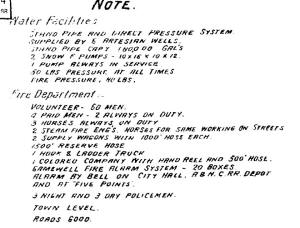
Sanborn Map of 1908:
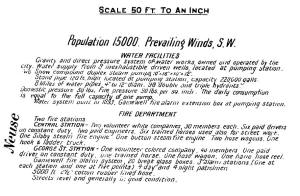

Except of history chart by Mike Legeros. See
original.
top
OXFORD

Mack Jones
Oxford is a good example of needing a water supply in order to fight fire.
An article in an August 18, 1905 publication. While discussing the progress
that Oxford is making states," The Oxford Water and Electric Co has been
testing the water supply. With the new tank only partially filled there is
enough water to put out a fire in the tallest building in Oxford". The test
was conducted on Hillsboro St., near the Opera House. Many homes are taking
advantage of the new company and installing electric lighting. They also
have a new ice plant, and now with the water supply they can organize a fire
department.
By this date three new companies have formed and Mr. S.M. Wheeler is named
chief. (he also delivers ice) . Mr. WA. Parham is elected foreman of reel
company #1. Mr. Robert Wood foreman of the Hook and Ladder company with Frank
Spence as his assistant. Reel company #2 is a colored company with Mr. Ed
Shelton as foreman and James Davis as his assistant.
Reel company #2 has taken the name Sixth Ward hose company. Two years later
they attend the 1907 tournament and convention held in Durham. There is no
information available of the number attending or their names. The Sanborn
Map of 1915 lists fire department equipment as two hose reels and a hook
and ladder wagon with 85 feet of ladders plus a 15 foot hook ladder (roof
ladder?). All of the equipment is pulled by men . The Sixth Ward reel company
acquired a Model T Ford truck in 1922, loaded with 1200 ft. of 2" hose
and two five gallon fire extinguishers. Other equipment in the department
was a hook and ladder with 100 ft of ladders and two hose reels used by both
black and white firefighters on a first come basis. Only one station accommodated
both black and white firefighters but meeting were held at different times.
They worked side by side at the fire scene but returned to the fire station
separately.
Mack Jones, was a member of the black fire company for several years beginning
in the 20s and staying until they disband.. Mack had a clear recollection
of some matters but others were hazy at the time of the interview June 30,
1995.
Mack is not a tall man, slender and very agile in his younger years. One
of his peers remarked that he remembered Mack dropping what ever he was doing
, at the sound of the fire alarm and racing to the fire house at top speed.
He enjoyed the annual meetings and tournaments of the state organization.
Mack participated in the ladder races. He was sought by the firefighters
from Weldon to round out their team at one of the tournaments. They needed
a climber. Mack competed with both teams working equally as hard for them
both.
When discussing the relationship between the races in the fire department
Mack felt all was well until an accident involving their company. The Model
T truck had been traded for a Model A. This truck was much faster than the
older one. James Hunt was driving on one occasion when Gus Burwell fell from
the truck while making a turn. Gus struck the curb with quite a force and
was seriously injured. He did not receive treatment at the time of the accident
but continued to be "sickly" and later died. It was never determined if his
injury was the cause of death but one of the white fire fighters made a remark
"we a supposed to save people not kill them.". This statement upset the black
firefighters and they held one more meeting but never fought another fire.
It was not so much the remark that caused the problem but the individual
making the remark. He was not considered friendly to the black firefighters.
There is not a complete roster of all the men who served Oxford but Mack
remembered , William Chavis, Tom Apple, James Hunt, Dan Willis, Langston
"Lank" Daniels, John Mayo, Bunion Shamly (Brian Chambrey?), Scott Burwell,
Willie Thorton, Leonard White, Charlie Harris, Tom Allen, Lee Fuller Prince,
Albert Harris and John Mayo as well as Gus Burwell and himself Mack Jones
names from other sources are W.M. Howerton, Thomas Lewis, Frank Royster,
(W.M. Burwell could be Gus or Scott?)Sam Owens, Alex Peace, Dave Marrow and
Saul Taylor.
The only fireman who died in the line of duty was Scott Burwell, a member of the colored company in 1935. Burwell fell from the running board on the way to a fire, and he died from his injuries.
The colored company dissolved in the 1940s, when many men left to fight in the
war and the company never reorganized. Source:
Oxford Fire Company,
Insert in the
Daily Dispatch, August 17 and 21, 2005.
Citations
- 1905 - The Swift Foot H. R. Company is listed
in the 1905 conference proceedings.
- 1909 -
Sanborn Map of 1909:
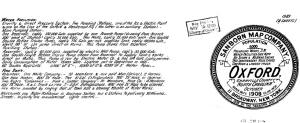
- 1915 -
Sanborn Map of 1915
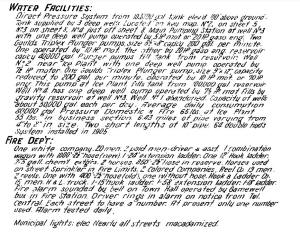
- 1912 -
Sanborn Map of 1922:
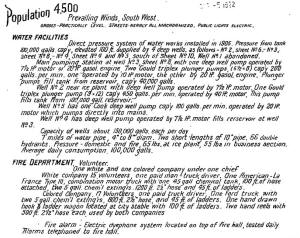
- 1923 - The colored fire company is listed in the 1923 conference
proceedings.
- 1928 -
Sanborn Map of 1928:
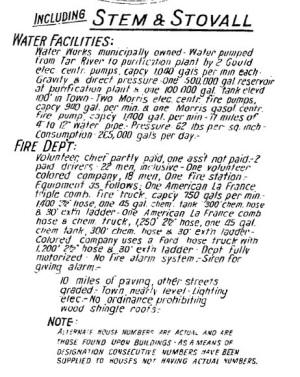
top
PRINCEVILLE
Princeville was established in 1865 by freed slaves had an all black fire
volunteer fire company sometime in the late 1800's.
Citations
- 1905 - The proceedings of the 1905 colored
firemen's association convention listed a Union H. L. Company of
Princeville, with delegates Turner Pender and Cary Farmer attending. Other
information about the fire company was included in a statistician's report.
The Fire Chief was Turner Pender. They were organized in 1905, had twenty
men, a hook and ladder apparatus, and $2,500 worth of property used for fire
service.
- 1906 - The Tarborough Southerner newspaper on March 8, 1906, reported that
"The Princeville Fire Company [colored?] not to exceed 20, and all to be
in good standing, was ordered to be exempt from poll tax."
- 1912 - The proceedings of the 1912 convention listed a Princeville Hand Engine
Co. No. 1, with these members:
Turner Pender, Chief
Frank
Walston, Secretary
Daniel Hammond, President
D. R. Knight, Treasurer
Thad Porter, Foreman
Virgil Anderson, Chaplain
Isaac Whitehead
Lawrence Farmer
John I. Jones
David Lonic
Noah Mooring
Peter
Cheery [Cherry?]
Reuben Colman [Coleman?]
Austin Porter
Thomas
Shivres
Orange James
Arthur Wooten
Mack Fields
Walter Spruell
- 1923 - The proceedings of the 1923 convention listed the Princeville H. R.
[Hose Reel] and H. E. [Hand Engine] Company, with Luther Bullock, Foreman,
Lonnie Mooring, Secretary, and members David T. Ward, Melva Ward, John Ward,
Raymond Ward, Eddie Bullock Jr., Andrew Garrett, Gariah Kee, Willian Lyons,
Willie Hatsuff, Will Chesnut, Howard Brown, and Cornelius Staton.
RALEIGH

James H. Jones
Photo Courtesy of Department of Archives, North Carolina,
N53 15. 5203
Being the capitol city of North Carolina does not exempt it from fire. Many
devastating fires plagued Raleigh in its infancy. Several fire companies
formed and later disband. A hose company composed of black fire fighters
was organized in 1869.
One of those assisting in putting the organization together was James H.
Jones. Jones had been born a free black in 1831. He was not formally educated
but relied on experience. Jones worked as a brick mason and plasterer in
his youth and in order to maintain himself he hired out as gentleman's servant
and waiter in the winter months of 1850.
In the summer of 1862 the Yankee's were threatening Richmond, and Jefferson
Davis sent his wife and family to Raleigh to keep them out of harms way.
Jones was hired to serve the Davis family while in Raleigh. Later that year
Mrs. Davis and her children returned to Richmond taking Jones with them.
Jones served the president of the confederacy as courier and coachman until
the end of the war. He was driving the president at the time of his capture
and arrest near Irwinsville Ga. He accompanied Davis to Fortress Monroe ,
Va. before returning home to Raleigh.
In 1868 Jones was appointed head door keeper for the North Carolina
Constitutional Convention. Later that same year he was appointed deputy sheriff
of Wake County and held that post until 1876.
The hose company that Jones helped organize was chartered by the state
legislature in 1872. He was elected foreman and served in that capacity until
1882.
A black bucket company had been organized sometime prior to September 13,
1877 for on that date The Weekly Register gave an account of a fire in the
kitchen of Mr. Z.W. Gill on Person St. that was burned down on Wednesday
last. The dwelling was saved through the exertions of the colored bucket
company. This was apparently a kitchen separated from the dwelling house,
which was the custom of that time .
The Victor Hose Company, which Jones helped organized served the city of
Raleigh for a number of years. In the 1880s the Victor Hand Engine company
and the bucket and ladder company were housed in Metropolitan Hall. The bucket
company gave way to more modern equipment and the hand engine and hose company
continued to serve until motorized equipment was introduced
The first company of colored firefighters in
Raleigh was formed by January 27, 1869. They were named
Fire Company No. 1 and operated an early 1851 hand engine. On October 20, 1870, the fire company
participated in a presentation competition of hand engines at the 10th annual
State Fair. They were the winners and were subsequently called the
Victor
Fire Company in the following days' newspaper accounts. They were
described as having about 40 members and with new uniforms that consisted of
black pants, red shirts trimmed with blue, and black belts and blue caps
trimmed to match the other parts of their uniform. The Victor Company received
a charter from the General Assembly on January 23, 1872. The incorporators
were James H. Jones, H. C. Jones, H. P. Buncombe, John E. Williams, W. B. Mitchell, Charles M. Hunter, Samuel Stewart, Sylvester Dunston.
They were housed in the basement of Metropolitan Hall after the building
opened on May 17, 1870. The Victor Company received a new Rumsey & Company
hand engine after June 1874.
Before the formation of the NCCVFA and the accompanying state conventions, the
Victors traveled to cities such as Charlotte, Wilmington, and New Bern in the
early 1880s. After November 6, 1885, the Victor hand engine was drawn by
horses. On March 1, 1890, the Victor Company received a two-horse hose reel.
By February 28, 1891, the Victor company had relocated to a single-story
engine house at the City Lot at the corner of Salisbury and Davie streets.. On
August 9, 1892, the Victors hosted the annual NCCVFA tournament in Raleigh. On
April 7, 1897, the Victor engine house burned. The night fire started when one
of the lamps on the hose reel exploded. It was quickly extinguished by the
nearby Rescue Company, but not before partially consuming the structure and
killing a pair of horses. The city was already planning to construct
replacement quarters for the fire company, and construction on the project
proceeded.
The Victors were later housed in a warehouse as temporary quarters until their
new station at 135 East Hargett Street opened on April 2, 1898. By this time,
the Victors had received a new horse-drawn hose wagon by July 20, 1897. On
August 26, 1902, the Victors again hosted the annual NCCVFA tournament in
Raleigh. On December 23, 1912, a fully-paid Raleigh Fire Department was placed
in service. The equipment and facilities of the volunteer fire companies were
utilized. The Victor station reopened on February 10, 1913, as Station 3. The
Victor Company, along with the other volunteer companies, were declared out of
commission on March 7, 1913.
A second company of colored
firefighters organized by September 11, 1872. Called the
Bucket Company, they
received a charter from the General Assembly on February 28, 1873. The
incorporators were A. L. Gorham [sic], J. W. Winslow, J. W. Butler, Ephraim Johnston, G. E. Lane,
and others. The fire company was also called the
Bucket and Ladder Company.
They were housed in the basement of Metropolitan Hall. They received a new
hand-pulled truck by May 19, 1876. Installation of fire hydrants in 1887
improved firefighting techniques in Raleigh, and lessened the need for
hand-powered aid such as hand engines and buckets. The Bucket Company was
disbanded and their apparatus sold after January 8, 1892.
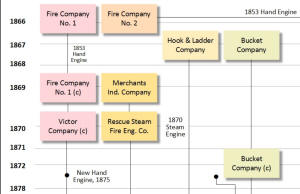
Excerpt of history chart by Mike Legeros.
See
original.
![[Image]](images/pict1.jpg)
Photo
by North Carolina Department of Sate Archives
Victor hose company in front of old station #3. Disband Dec.23,
1912.
This circa 1913 photograph shows the Victor Company engine house. This is Fire Company #3 of the now fully-paid
Raleigh Fire Department, which was placed in service in December 1912. The former Victor
Company engine house served as Station 3 until 1951.
The structure was subsequently demolished. Pictured from left to right are (in the back) Charles F. Gaston, Luther C. Thompson, and W. Ernest Holland; (in the front ) Eugene E. Jones (standing), Henry M. Parrish, and Matthew J. Barker (driver).
Source for names: North Carolina State Archives.
Career black firefighters were proposed as early as 1952. The 1952-53 fiscal
year budget document contained the following message, likely from Fire Chief
Alvin Lloyd: "We have had under consideration the setting up of Negro
Company and believe that this should be considered and kept in mind as the
department develops. I could find no way in this budget to make the
changeover at this time. I believe after the new Central Station is set up
and the equipment is rearranged that such a company could very well fit into
the department."Âť This was likely a response to the formation of a black fire
company in Winston-Salem in 1951.
The first career black firefighter, Larry Gene Williams, was hired in 1963,
with seven hired between February 1963 and March 1964. They were Williams,
Welton Jones, Ervin Louis Stephens, James Leon Giles, James Greene Jr.,
Norwood Matthew Peacock, and Richmond Davis Jr. Six were moved to Station 2
at Memorial Auditorium between March 1963 and April 1964. Stephens was
assigned to Station 1. They staffed Engine 2, along with a white officer and
driver. They operated as integrated fire company, but with segregated living
quarters. Five of six members were transferred to other stations in August
1965, thus integrating entire fire department.
top
ROCKY
MOUNT
By Todd Joyner and Scooter
Hedgepeth

Photo courtesy of North Carolina
Department of Archives N76 6 52
On March 11, 1896 the town council approved the first black fire company
and appointed D.D. McIntire as its foreman. This bucket brigade, composed of
26 men, was stationed in the 100 block of East Thomas Street. The company
was responsible for the operation of the hand drawn hook and ladder wagon.
This was a well trained and efficient company and as Captain E.J. Pitt recalled
on one occasion were able to arrive at the fire and have it under control
before other equipment could be set up.
This group of men attended many of the state conventions and tournaments
walking a way with several awards for their skill and speed. In 1906
while practicing for an event at the upcoming tournament in Warrenton, North
Carolina, Henry Mitchell died of a heart attack. (fom the Evening Telegram,
6 July 1967). This was the first firefighter of record to die in
the line of duty.
In 1903, Bynum "Boo" King was a jailer for the City Police when he was given
the opportunity to become caretaker of the fire horses and paid driver for
the fire department. King lived in the fire station from 1904 until
his death July 31, 1940 at the age of 97. He had requested that a fire truck
be used as his hearse at his death. His request was granted and Engine
3 rolled out "Bertha" to give "Boo" his final ride. The rest of the black
fire company lost interest and disband in 1914.
Citations
- 1904 - The Raleigh News & Observer on August 12, 1904, reported that colored fire company from Rocky Mount named Excelsior
attended the 1904 convention in Wilson.
- 1905 - The Excelsior H. and L. Company is listed
in the 1905 conference proceedings.
- 1912 -
Sanborn Map from 1912:
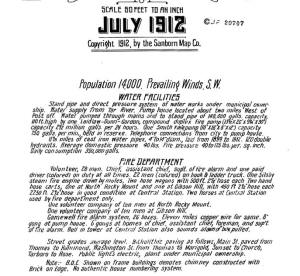
- 1917 -
Sanborn Maps from August 1917
describe the fire department as consisting of five paid men, four volunteer
companies, and also 22 colored men on a hook and ladder truck.
top
SALISBURY
"An Act for the regulation of the Town of
Salisbury, securing the Inhabitants in their Possessions, and to encourage
the Settlement of the said Town.
And to prevent Dangers arising by Fire, Be it Enacted,
by the Authority aforesaid, That each and every Householder within the said
Town of Salisbury, shall procure or cause to be procured, two sufficient
Leather buckets, and a Ladder and keep same in continual readiness against
any Alarm that may be given, occasioned by breaking out of Fire at any Time
in the said Town; on Penalty of paying Twenty Shillings Proclamation
Money."
As the above clearly shows Salisbury was aware of the dangers of fire in
an early time. In somewhat more modern times there is documentation
to show that in 1867 S.E. Linton was to take charge of the hose reel and
fire engines and to organize the fire companies. A name is mentioned
for one of the fire companies as Freedmen consisting of thirty to thirty-five
members. This must have been black firefighters as white firefighters
would not have considered such a name.
Salisbury hosted the conventions for the states white organization on several
occasions but it also hosted the convention of black firefighters on at least
one occasion in 1900. This was the 11th annual convention according
to newspaper accounts. This being true would indicate that the first convention
was held in 1889. Following this line would then take us back several
more years to the organization of individual black fire companies. 1867
would not seem unreasonable to consider as the first organized black fire
company in Salisbury. These men were volunteers according to documents
used for this research. Emancipation gave these men freedom and with
that came responsibility. Responsibility to help protect their fellow
man from the dangers of fire. Document show black firefighters
still active in 1907 giving them forty years of active
service.
Citations
- 1869 - The Tri-Weekly Examiner on
August 18, 1869, featured this reference to the colored fire company: "This
excellent Company has done yeoman's service since its organization. Many
Fires have occurred, and but for the presence and commendable efforts of
this excellent Company the results would have proved much worse. On Sunday
night, it did full credit to its former reputation."
- 1877 - The Carolina Watchman in 1877
included references to the colored fire company, including about their
members being "on parade" on Saturday evening and that their engine had been
recently repaired, painted, and "throws water now better than it ever did."
(March 8, 1877). Also, about $100 allocated by the town commissioners for "uniforming"
the colored fire company, along with $200 for "uniforming the Hook & Ladder
Company". (December 20, 1877)
- 1878 - The Carolina Watchman on
November 7, 1878, included an account of a house fire and that the colored
fire company "responded promptly and did their best" but didn't arrive at
the house until the building "was falling." The company "had about ten yards
to run and no horse to draw the engine."
- 1866 - The Carolina Watchmen on April 8, 1886, reported that the "negro
fire company had their newly repaired engines out last Saturday evening,
testing their qualities. They throw water very well. Noww furnish the water
and they will be prepared to work."
- 1892 - The Carolina Watchman
on July 14, 1892, mentioned that "the captain of the fire
department presented the names for the re-organization of the colored fire
company."
- 1904 - The Raleigh News & Observer on August 12, 1904, reported that a colored fire company from Salisbury called the Athletes Hose Reel #4
attended the 1904 convention in Wilson.
- 1905 - The Athletic H. R. Company is listed in the
1905 conference proceedings.
Sanborn Maps
- 1902 -
Sanborn Maps from February 1902 describe department as:
Volunteer with
a Chief and one driver, paid. Two horses "for fire duty only, kept in livery
stable, two squares from town hall." Stable to be "arranged" at Town Hall
for same. Fire alarm by bell at Town hall. Telephone connection with pumping
station. Ninety-five double hydrants.
One hose company, white, with sixteen men. One hook and ladder company,
white, with eight men. One hose company, colored, with twelve men. One,
one-horse new hook and ladder truck. One one-horse new hose wagon. Four hand
hose reels. 1700 feet two-and-a-half inch cotton rubber-lined hosed. 300
feet two-and-a-half inch rubber hose. 500 feet of two-and-a-half inch cotton
rubber-lined hose ordered.
- 1907 -
Subsequent map of August 1907 lists the same fire companies and membership
numbers.
- 1913 -
Subsequent map of November 1913 lists only one company of partly paid
members, no race indicated.
top
SMITHFIELD
Documentation is available to show the presence of black fire fighters here
but not enough information for a report.
Sanborn Maps from September 1915 lists the fire department as volunteer
with a Captain, ten white, and ten "negro men." Two hose reels and one wagon.
Equipment included 1,500 feet two-and-a-half inch hose, ladders, and a fire
alarm system with whistle and bells. Town had forty-four double hydrants.
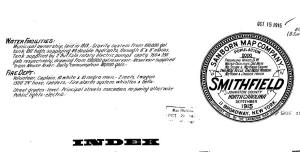
The prior map of 1908 lists only "ten volunteer firemen."
The subsequent map of September 1924 lists the fire department as partly paid,
with a Chief, Asst. Chief, and twenty-eight men, half of whom are colored. One
Reo combination auto truck with 450 GPM pump, 40 gallon chemical tank, and 800
feet two-and-a-half inch hose. One Oldsmobile automobile truck with 40 gallon
chemical tank and 1200 feet two-and-a-half inch hose. Two hose reels and 500
feet of two-and-a-half inch hose. Trucks kept at garage. Driver sleeps in
building. Phone in room and in driveway, near trucks. Alarm by phone. Electric
siren at City Hall and bell to give location of fire. Town has sixty-four double
hydrants.
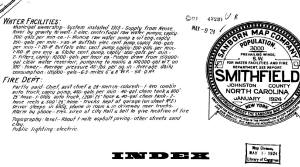
Sanborn Map of 1937:
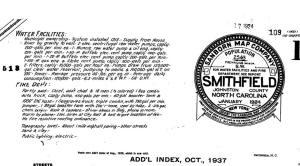
STATESVILLE
In 1905 Statesville boasted 125 black volunteer firefighters. This story
will be updated at a later date.
Citations
- 1878 - The Statesville American and Tobacco Journal on October 12, 1878,
reported that the colored citizens of the city organized a fire company,
with the election of these officers: John P. Murphy, President; Dennis
Moore, Vice-President; R. D. Bailey, Recording Secretary; C. O. Hampton,
Corresponding Secretary; M. W. Phillips, 1st Director; J. R. Murdock, 2nd
Director; J. A. Haines, 3rd Director, F. R. Hoke, Treasurer. The company was
comprised of 35 active members.
- 1893 - The Statesville Record and Landmark (SRL) on June 15, 1893,
reported that the colored fire company, which had "been in existence here
for many years," met on Monday night to reorganize. Nine of the "old
members" were present. The reorganization was deferred until the next Monday
night. New members were being received and the colored citizens proposed to
create a fire company "to take charge" of the hand engine. They were also
willing to organize a hook and ladder company, if the "necessary equipments"
were furnished to them.
- 1894 - The SRL on February 1, 1894, reported that
the hand engine bought by the town for the colored fire company arrived on
Saturday, and the company "was out for practice" that afternoon. "The new
engine worked to perfect" and the company "made a run from the cistern below
to the post office to the one in front of the Messrs. Wallace Bros, adjusted
the engine and threw a stream of water in just five minutes from the time of
start." The company had 50 members, J. P. Murphy was the president, Pomp.
Sharpe first director, Clay Gaither second director, and Geo. Stewart third
director
- 1894 - The SRL on March 8, 1894, reported that fire company
members were soliciting subscriptions to purchase uniforms.
- 1894 - The SRL on May 31, 1894, reported that at a Monday meeting, the
following officers of the Defiance Fire Company were
elected: J. P. Murphy, President; F. F. Chambers, 1st Director; S. G. Gray,
2nd Director; G. W. Stewart, 3rd Director; R. D. Bailey, Secretary; J. A.
Richardson, Treasurer; J. W. Gaither; Janitor.
- 1895 - The SRL on December 3, 1895, reported that at yesterday's meeting
of the city aldermen, the chairmen of the fire committee was directed to buy
a hose reel for the colored fire company.
- 1897 - Statesville colored fire company members attended the 1897
convention. Source: Newspaper article.
- 1898 - The SRL on May 31, 1898, reported that the colored fire company
held their banquet and annual election on Friday night at Firemen's Hall.
About 60 people were present, including invited guests.
- 1905 -
Sanborn Map of 1905:
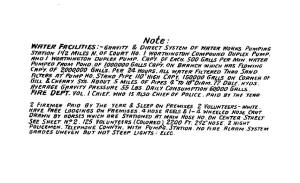
-
1905 - Defiance H. R. Company No. 2 listed in
conference proceedings.
-
1906 - The SRL on April 3, 1906, reported that a request was made to the
board of alderman that the current fire companies be disbanded, so other
companies could be organized. This followed a meeting of some citizens held
the night before, that wanted to have "better firefighting teams" than the
city had had in the past. They proposed to organized one company of 15 white
men and one company of 15 colored men, each to practice once a month. And
for their services, they will have their poll tax remitted, and received 50
cents for each practice attended, and $1 for each fire attended. They would
also ask for additional fire apparatus.
- 1908 - The Raleigh News & Observer on August 12,
1908, mentioned that a colored fire company from
Statesville called Defiance Fire Company No. 2 attended the 1908
convention in Rocky Mount.
- 1911 -
Subsequent map of May 1911 lists a fire company of eighteen men, with two
paid men on constant duty, and five who sleep on premises. Race of members
not noted.
- 1923 - The Defiance fire company is listed in the 1923
conference proceedings.
- 1946 - The SRL reported on July 8, 1946, that the
colored members of the volunteer fire department were: Andy Blackburn, J. Q.
Davidson, Bob Ellis, and Mel Feimster.
Hose & Nozzle magazine, August 1958.
Statesville Negro Firemen Retire After 45 Years.
Like the water pits they recalled of years before, they are giving way to
newer things. Where big holes used to stand to catch the rains, water lines
now run. Hand pumps have been replaced by gasoline engines. Now, some 45
years after they joined, Melvin Feimster and J. Quincy Davidson are retiring
from Statesville Negro Volunteer Fire Department. They are the last of 15
Statesville Negroes who formed the volunteer outfit way back in 1894. All
the others are dead.
Feimster and Davidson were not original members of the unit--they were too
young back then--but they joined as soon as age permitted. And in the
intervening years, they have seen the local battery of volunteers grow into
a permanent force backed by 18 full-time firemen and equipment that would
have appalled them 45 years ago.
"With all this modern equipment, one man can do as much as six used to do
back then," quipped Davidson, now in his 70th year. He recalled old
fire-fighting tactics in Statesville, even long before he joined the
volunteers, when there were no water lines in the city." They had to pump by
hand back then," he said. "There weren't any water works around here
anywhere then, except what rained in the pits."
The "pits" he referred to were nothing but holes in the ground that caught
water from the rains. There were nine of them in the downtown fire limits.
"When there was water in them were were all right," Davidson remarked, "but
during a dry spell, a fire could burn up everything around here."
But the installation of water mains across the city in 1898, the retiring
firemen recalled, still wasn't guaranteed protection against devastating
blazes. The worst fire of their recollection was to come the night of
January 10, 1923, when billowing flames devoured 17 homes, an old herb house
and laundry on Depot Hill. "That fire burned up every darn thing on that
hill," Davidson recalled.
Nor were their years of service to the city to go without incident for the
last of the Negro volunteers. Both, at one time in their careers, have been
overcome by smoke."
Sanborn Fire Insurance map of March 1905 lists department as volunteer with
a paid Chief who is also Police Chief and receives annual salary. Two career
firemen who sleep on premises. Two white volunteers who have free lodging on
premise. Four hose reels and one four-wheeled hose cart drawn by horses,
which are stationed at main hose house on Center Street. 125 volunteers,
colored. 2200 feet two-and-a-half inch hose. No fire alarm system.
Seventy-seven double hydrants.
TARBORO

Fulton Hook
and Ladder Company Band. Tarboro
Photo courtesy North Carolina
Department of Archives 76 6 50
Documents dated 1901 and 1913 show 25 colored firefighters manning the hook
and ladder. No other information is available at this time.
Citations
- 1901 - The Tarborough Southerner on April 11, 1901, reported on the
colored fire company "out for practice" on Monday. "With the truck three
dashes 100 yards each were made in 25, 20, and 17 seconds respectively.
At each dash a ladder was taken from the truck, placed in position and
mounted. The time of the first two was not taken, but that of the third
was. Including the dash the ladder was taken off, put up, mounted and
again placed on the truck in the creditable time of 41 seconds. George
Lucas was in command. Jordan Dancy did the ladder climbing with great
agility and ease. In the evening an entertainment was given at Jeffress
warehouse to aid the firemen in procuring uniforms."
- 1901 -
Sanborn Map of October 1901 lists department as volunteer with
three hose companies, ten men each, white. One hook and ladder company of
twenty-five men, colored. 2500 feet of two-and-a-half inch C.R.L. hose. All
apparatus drawn by hand. Alarm by bell at Town hall, "which locates the fire
district." Forty-three double hydrants in town.
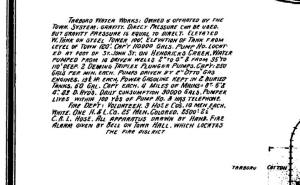
- 1902 - The Tarborough Southerner on February 6, 1902, reported that
the members of Fulton No. 3 "offered a medal to the
member who was first at the truck for fires. Daniel Bridgers won it for
last year and will wear it this. The medal is silver and is handsome and
appropriate. It can be seen in M. Heilbroner's window."
- 1904 - The Raleigh News & Observer on August 12, 1904, reported that
the Fulton Fire Company attended the 1904 convention in Wilson.
- 1905 - The Fulton H. and L. Company is listed
in the 1905 conference proceedings.
- 1913 -
Sanborn Map of October 1913 lists department as volunteer except
one fully-paid driver. One chief, sixty-nine volunteers: forty-four white
and twenty-five negro. One American LaFrance 70 HP automobile combination
engine and hose wagon with one 50 gallon chemical tank, 200 feet of chemical
hose, and 1250 feet of two-and-a-half inch C.R.L. hose. One horse-drawn hose
wagon. One Nott 60 gallon chemical engine with 125 feet of chemical hose.
One hand-drawn service hook and ladder truck, operated by "Negro Company"
with twenty-five members. Three hose reels each with 300 feet two-and-a-half
inch C.R.L. hose. 2,500 feet good two-and-a-half inch C.R.L. hose. 300 feet
ordinary hose. Two five gallon chemical extinguishers. Six three gallon
chemical extinguishers. Town has sixty-three double hydrants.
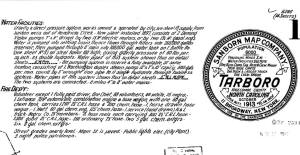
- 1923 -
Sanborn Map of 1923:
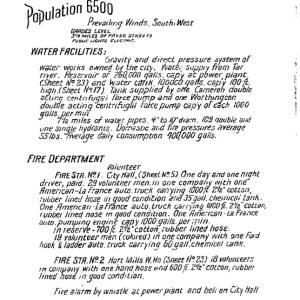
- 1923 - The Fulton Hook & Ladder Company is listed
in the 1923 conference proceedings.
- 1928 - The Raleigh News & Observer on August 21, 1928, reported that the Fulton
Hook and Ladder Company was attending the annual state convention in
Concord.
top
WAKE FOREST
In 1917 the fire district was established and a fire department was organized.
T. M. Arrington was appointed Chief and J.L. Taylor was to serve as his
assistant. As in most early fire departments a hose reel was the main piece
of equipment. The reel was kept at the water tank. At some point a black
fire company was also formed and of course a hose reel was their first equipment
as well.
The hose reel with 500 ft of 2" hose along with other equipment became
more than the volunteers wanted to pull. As all good firefighters will they
came up with a better idea. John Brewer had an old Westcott automobile he
was willing to part with. No one knows how they were able to raise the money
but somehow they got the funds together and made the purchase. Everyone knows
that you can't make a fire truck out of an automobile but everyone knows
a firefighter will take advantage of any opportunity. First they cut the
top off. Next they constructed a bed for the hose and a basket was installed
to hold chemical tanks, provisions were made for carrying ladders. It may
have looked like the Beverly Hillbillies but it served well for several years.
The Wake Forest College Campus was a part of the town protected by the volunteer
department. Sometime in the early or mid thirties a student enrolled there
that was bent on burning the place to the ground. The department had their
hand full with the Chapel suffering heavy damage, Hunter Dormitory was set
on fire three times and Wait Hall was totally destroyed before student patrols
discovered the arsonist in the act and ended his career. This got everyone's
attention and an effort was made to get better equipment In 1934 a new pumper
was purchased for the town. The 1934 Chevrolet remained in service until
1948 when a new pumper was delivered and it was moved to the number two station
to serve as first line for the company of black firefighters.
The black fire company at #2 was formed about the same time as the white
company both having began with hose reels in the late teens or early twenty's.
They were just as ingenious as the white firefighters when it came to equipment.
Frank Keith was chief of the white fire company in the early years and also
operated a grocery. Keith used a open sided delivery truck for his grocery
wagon. When it came time to replace the grocery wagon with a more modern
truck the old wagon became the hose wagon for number two.
Wake Forest Fire Department #2 was formed after
May 7, 1942, after the Town Board appointed a committee to investigate
"advisability of encouraging the formation of a Colored Volunteer Fire
Company." WFFD #2 merged with town fire department around February 1982.
(Alternately, the year 1979 is cited as the year the department ceased
operations.) In 1983, the town and rural fire departments
merged. The former WFFD #2 station was
located on Taylor Street and converted to a community center. It was heavily
damaged by a fire on
February 2, 1983.

Wake Forest Fire Department #2, c. 1953.
Pictured with their 1948 Chevrolet
pumper are, left to right, Chief Edward Alston, Matthew Williams, George Massenburg, and Robert Alston. (Courtesy of Wake Forest College Birthplace
Society.)
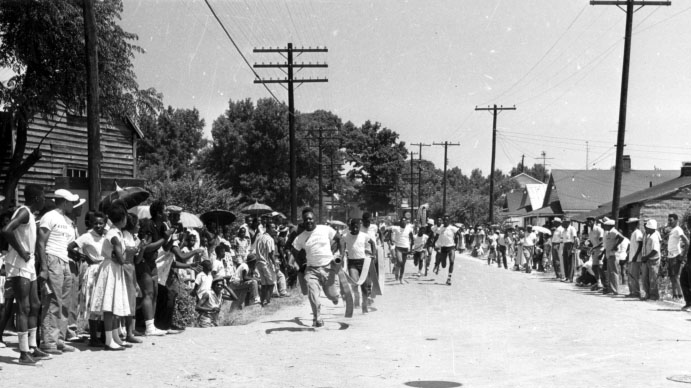
Fireman's Games, July 12, 1957.
Members of Wake Forest Fire Department #2
compete in a closing event of the 67th annual session of the North Carolina
Volunteer Fireman's Association, which was held at DuBois High School in Wake
Forest. The all-black fire department was formed in 1942. (N&O photograph.)
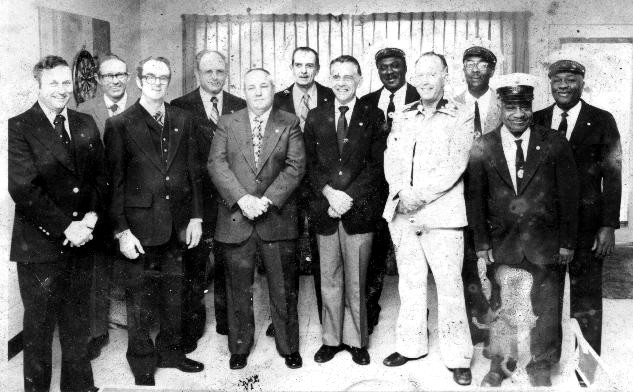
Reunion, c. 1978-1979.
Former Wake Forest firefighters are
pictured from left to right: J. Albert Perry, Hubert K. "Doc"Âť Denton, Raymond C.
Keith, Willis H. Winston, George Timberlake Jr., J. Bruce Keith, W.H.
"Buddy"Âť
Holden, Woodrow Williams, W.W. "Bill"Âť Holden, Oscar Smith, Mckinny Mitchell, and
Edward "Ed"Âť Alston. (Courtesy of Wake Forest Fire Department.)
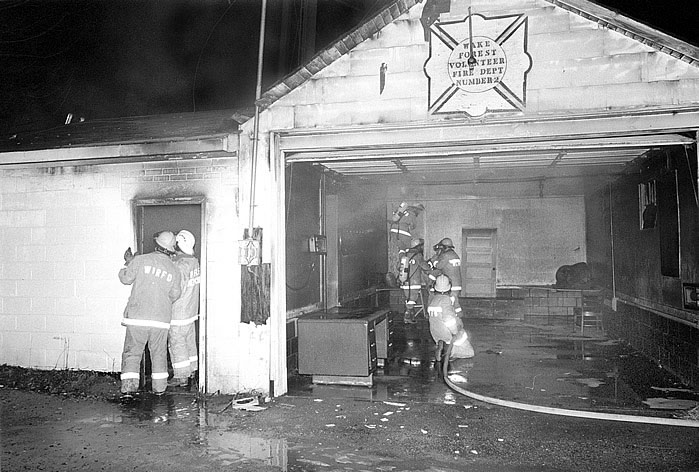
Fire Station Fire, February 2, 1983.
Severely damaged by a suspicious fire, the
former quarters of Wake Forest Fire Department #2 on N. Taylor Street had been
empty since the town's three fire departments merged a year before. (Wake Weekly
photograph by Greg Allen.)
top
WARRENTON

Restored hand drawn Hook and Ladder now in the
North Carolina Museum of History.
Photo courtesy
North Carolina Department of Archives N 76 69
In the year 1869 the time had come that something had to be done about the
fire protection in Warrenton. Two wells were located on the grounds of the
court house and could furnish enough water for a bucket company. A time was
appointed that black citizens would meet in one location and white in another
to organizer fire companies. The black group numbered twelve men. The white
group never met. No funds were available and no equipment. What could twelve
black men do to fight fire in a situation like this? Take the situation in
hand and do what they could with what they had. Oil cans were the only containers
available at no cost so a bucket company was formed using available oil cans
for buckets to fight fire. The water supply was to be the wells at the court
house.
A later improvement for the bucket company was the addition of a cart or
small wagon. It was to be hand drawn and loaded with buckets and ladders.
A huge shield was used to get closer to the fire with their water buckets.
Notification of fire for this early bucket company was probably by voice.
Any one discovering a fire would shout "FIRE" and any one hearing the alarm
would repeat the cry "FIRE" the message was repeated by anyone hearing it
until all were alerted. In these early years this was enough to strike fear
in any ones heart. Fire was a terrible thing to happen to any town.
Numbered among the early fire fighters was one Jimmie Ransom. Jimmie and
his brother were skilled craftsmen and ran a wagon shop. These men took it
upon themselves to built a wagon for transporting ladders with hooks and
chains and buckets. They completed their project, and placed the wagon in
service even with no horses to pull it. Man power was used to pull the wagon
for some time .
Cisterns were dug and a hand engine was purchased to give even better service.
After horse drawn wagons became obsolete a Model-T Ford was purchased. This
was used for a number of years.
Even with the crude methods of communication these men were able to learn
of other black fire companies in the state and by 1888 they had band together
to form an organization called the North Carolina Colored Volunteer Fireman's
Association. John S. Plummer became the driving force behind the organization
and remained president of the group for a number of years. From the day of
its inception the Warrenton Fire Department has always had a Plummer on its
roles. John S. Plummer, the first chief of Warrenton, served for 25 years
as president of the state organization. Baker Plummer who was born in 1881
served for 67 years as a fireman also being president of the North Carolina
Colored Fireman's Association for three terms. To be a Plummer is to be a
fireman.
Citations
- 1891 - Sanborn Map from 1891:

- 1904 -
The Raleigh News & Observer on August 12, 1904, reported that two colored fire company from Warrenton called Hand Engine No. 1 and Hand Engine No. 2
attended the 1904 convention in Wilson.
- 1905 - The Plummer H. and L. No. 1. Company and
Plummer H. Engine No. 2 Company are listed
in the 1905 conference proceedings.
A 1949 news account of the convention and tournaments was published in the
Warren Record. Eight towns were represented at this convention The schedule
of events listed were a business session, a dance, a baseball game, races
and a dinner. The account also told of a 1900 document giving the minutes
of the meeting held in Salisbury, North Carolina September 11-12-13 of that
year. It listed duties of a fireman as: " Its every fireman's duty to be
ready for a call with engine, hose and ladders and horses in their stalls.
Like an army to action when it is in the field against fiery courage, the
fiery pot must yield its every fireman to duty when on duty there comes a
message swift and sure . . he must use both his nerve and skill in order
that water shall soon win the day. And its every fireman's duty to obey his
captain's orders wherever he be. His work with courage will be only done
if he obeys."
An incident in 1967
Mary Louise and Roger Limer liked sitting on the porch late on summer evenings.
Mary Louise's former home in Yonkers, New York didn't afford such luxuries
as sitting on the porch watching and waving to friends as they passed by.
It was a time to unwind and discuss the things they needed to do. There was
no remote control for Roger to flip through endless channels. The remote
control had not been invented. Besides, they enjoyed each others company
to much.
On such an evening, probably in late July, they sat relaxing. Mary Louise's
gaze happened to wander to the tobacco warehouse across the street. A one
hundred foot tall 17,000 gallon water tank was in back of it. The tank held
a reserve supply of water. The elevation gave it the pressure it needed to
bring water out of the taps of the residents of Warrenton. "Roger," she asked
"where would all that water go if that tank were to somehow burst?" Without
much hesitation, Roger suggested, "Now think about it just a moment, Mary
Louise, where do you think it would go?" "Well I guess it would just go straight
down," she replied. The tank was dismissed from her thoughts as she contemplated
another problem. "Roger, wouldn't it be nice if the porch were screened in?"
Mary Louise asked next. " I think that would be nice. Why don't you find
a carpenter that could do that for us." answered Roger.
After searching for several days and getting promises, work finally began
on the screened porch. The job was coming along nicely until late on the
evening of August 14, 1967.
About 9:00 PM someone discovered smoke coming from the tobacco warehouse
across the street from the Limers. An Alarm was sounded and the firefighters
responded in full force.
Warrenton is very proud of their fire department. The company was founded
in the 1860's and has served the city well from that time. The company takes
pride in the fact that they are the oldest black fire company in the state.
The reputation of the Warrenton fire department was soon on the line. The
fire was rapidly growing out of control. A call for assistance was sent to
Warrenton Rural Fire Department and Norlina as well as other neighboring
communities. Thirty five fire units were finally on the scene but things
did not look good. During the first few moments of the fire, wires began
to fall causing a power outage. The towns water pump was knocked out.
Roger Limer had a front row seat to all the action, as he watched from his
front porch. It was quite a spectacular event, not even the firefighters
had a better view. The struggle to gain control of the fire was not going
well at all.
No one could have predicted what would happen next. The heat was so intense
that the legs of the one hundred foot water tower were weakened and the structure
buckled.
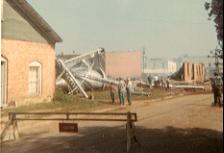
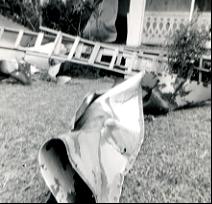
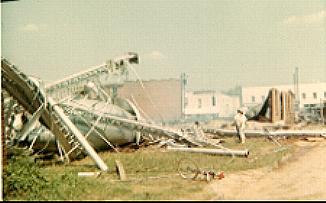

The tank and its contents crashed to the ground right in the center of the
warehouse. Metal fragments as well as other debris flew in every direction.
Grady Moseley, a bystander suffered a sever shoulder injury. Warrenton
firefighters, Claude Harrington and Joseph Richardson were injured by flying
steel. Asst. Chief McCarroll Alston, was burned from the shoulder to the
elbow. Willie Robinson of the Warrenton Rural Fire Department was overcome
by smoke and heat. The front seat that Roger Limer had enjoyed came at a
high price. The tidal wave of water from the fallen tank knocked Roger from
his feet and bounced him around severely. The double front door of the house
gave way to the rushing water and the deluge poured into his home with gusto.
Roger spent a short time in the hospital while Mary Louise dealt with all
of the carpenters lined up to seek work at her house. The front porch was
soon screened and other repairs made but the view was not the same. Several
of the neighbors homes also suffered damage, as well as other businesses
along the street.
The reputation of the Warrenton Fire Department was left intact as the falling
water tank all but extinguished the fire. If there is a moral to this story
it would be "Don't put all your water in one bucket."
top
WASHINGTON
Since 1889 the North Carolina Colored Volunteer Fireman's Association has
held an annual meeting, usually in August. As in most communities this is
a month where the occurrence of fire has a low possibility due to not requiring
heat in any buildings. Even with this consideration the question comes to
mind. Can we let an entire company leave town for several days and not expect
at some time that the odds would catch up to us?
For some yet unknown reason the annual meeting for the year 1900 was held
in September. The meeting was held in Salisbury and The Salamander Company
from Washington was attending . The tournament and other business closed
out on Thursday evening, September 13, 1900. The different delegations began
packing up and departing. The Salamander team boarded their train early Friday
morning. The Salisbury evening paper carried the following story.
"Washington, N.C.,
Sept.13------------------------------------Washington is in ashes. From Water
street beginning at the oyster factory up the street a distance two hundred
yards or near to the Crystal Ice Company factor, and from the corner of Water
street up to Market street to Main street, our town lies in ruins that never
have been surpassed in its history since the civil war, and the property
loss far exceeds that o the war when our town was burned by the Yankees,
the loss being approximately one hundred and fifty thousand dollars. Upon
a careful examination it is presumed the loss will far exceed these
figures.
The fire originated in Brabble's restaurant about
on o'clock caused by a defective stove flue. In a few minutes the building
was a total loss and the fire had spread to all adjacent
buildings.
All citizens of the town, both white and colored,
did valiant service. The fire raged from 1:15 to 5 o'clock. Many were prostrated
by the excessive heat.
Mayor Studdert wired the fire departments of Greenville
and Rocky Mount for assistance, as the whole town was at one time in danger.
The Greenville fire company is now on the scene and the fire is under control.
------ Raleigh Post "
The first discovery of a record of a death of a black firefighter in North
Carolina was Edward Peed of Washington.
Charles Yates began a search for the grave of Edward Peed in 1997. After
a long and tireless effort he finally found the head stone in an old private
black cemetery. The stone had been pushed over by vandals but he was able
to read the inscription.
Peed's death had been forgotten over the years until Charles Yates completed
his search. His name is now a part of the history of the Washington Fire
Department.
The following was written by Charles T. Yates,
Volunteer Fireman,
Washington, NC Fire Department 1951-1976:
The Washington Fire Company, forerunner of the present Fire Department was
organized in 1791. The present Fire Department organized 1892. The volunteer
fire company known as the Salamanders wore red helmets and sang as they operated
their hand pumps. ( This is mentioned in another area as a way to coordinate
their efforts.) Membership in this company was highly prized and the company
was composed of the most outstanding black men in the community. The company
was led by Professor Sylvester Dibble who, with a partner, operated the only
barber shop in Washington. In 1904 there were 201 volunteer firefighters
in Washington of which 86 were white an 115 colored. The fire equipment consisted
of One Silsby steam engine, one small hand engine and two large hand engines.
Five 2 wheel hose carts one supply wagon and one hook and ladder wagon.
The year was 1881 when the Salamander Fire Company was chartered in the town
of Washington, North Carolina. This all black volunteer company wore red
helmets and sang songs as they operated their hand pumps at local fires.
Citations
- 1901 -
Sanborn Map from 1901:
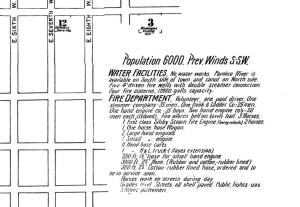
- 1904 - The Raleigh News & Observer on August 12, 1904, reported that the Salamander Fire Company
attended the 1904 convention in Wilson.
- 1905 - The Salamander H. R. No. 1 Company and the Dibble
H. R. Company
are both listed in 1905
conference proceedings.
- 1916 -
Sanborn Maps from August 1916 list
a colored fire company housed in the 100 block of West 5th Street, one of four
fire stations. The company had 30 men and two hose reels with 1,000 feet of 2
1/2-inch hose.
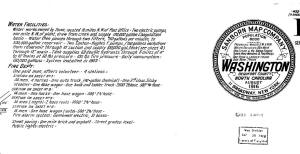
One fire with a sad ending occurred on February 8, 1902 in downtown Washington,
N.C.. It began about 5:25PM on this Saturday afternoon from a defective flue
at the Atlantic Coast Line Freight Warehouse which was located on the local
water front. In a short time the entire building was in flames, and for a
time, it seemed that the town was at the mercy of the fire, mainly because
the steam fire engine had failed to work!
The fire spread rapidly, first to the grain elevator building, then to the
Hoyt Store, occupied by E. Peterson Co. and on to the warehouse at the rear
Of H. Susman Furniture Co. , plus a number of sheds on the water front. Finally,
at 8:30PM, the fire was brought under control and clean-up operations began.
Shortly after 9PM, Edward Peed, a nozzleman for the Salamander Fire Company,
was standing, throwing water on some of the rubbish when suddenly, and without
warning, the western wall of the Hoyt Building, fell on fireman Peed, killing
him instantly
Edward Peed was a very worthy colored fireman and all the citizens of Washington
regretted his sudden death. Mr. Peed had been a member of the Salamander Fire
Company for 20 years and was the first recorded fireman to die at the post
of duty here in Washington, N.C.

Peed's stone in foreground.
A monument was erected by the white citizens and placed at his gravesite
in appreciation of his faithfulness and service to his community. Mr.
Peed died at the age of 46, leaving a wife Frances and two sons. he was buried
in a local cemetery known as FAIR-VIEW. The last known burial there was in
1920.
While doing some research work for C.J. (Chuck) Milligan, a retired Captain
of the Durham, N.C. Fire Department, who was in the process of writing the
history of colored fire fighters in North Carolina, I discovered a graveyard
of disgrace where stones and grave markers had been over turned and many
broken as they lay among rubbish of bicycle parts, broken bottles , bricks
and other debris. Pictures were taken to document this condition.
Certainly our fallen brother deserved a place of honor and not disgrace.
It was then that I presented my story to Fire Chief Nelson Pyle of The Washington
Fire Department, suggesting that a memorial garden be created at the station
and efforts be made to transfer the monument of Edward Peed to the new location
, giving him the recognition that he so richly deserved.
After two years of discussing and planning, the memorial garden became a
reality July 29, 2000 , as local citizens attended Open House to view new
fire equipment, to review promotion ceremonies of several firemen and to
view the memorial garden which now proudly contains the monument of Edward Peed,
born March 1, 1855 and died February 8, 1902 at the post of duty.

After 98 years of silence; "Let Us Not Forget"
top
WELDON
Sanborn Maps from June 1915 describe
the fire department as consisting of two volunteer fire companies, one white and
one colored, with 11 men each. Fire equipment was housed at the Town Hall at 303
3rd Street and at three hose houses.
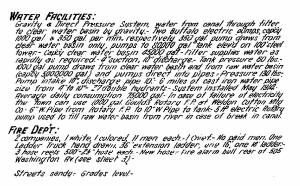
top
WILMINGTON
The early days of Wilmington were not easy. The town had been laid off by
an incompetent survey. A later survey found houses infringing on city streets
or on a neighbor. Considerable development had taken place and it took some
time to get it all in its proper place. As early as 1745 the wooden chimney
had already become a fire hazard to deal with. Rubbish and flammable stores
were a problem as well.

A tax of no more than 2 per cent in Proclamation Money was authorized and
the proceeds were to be applied to the purchase of buckets, ladders and one
or more water engines as well as a town bell for alarm.
By 1767 the engine that had been purchased with the taxes earlier mentioned
was now in disrepair and the town was given six months to get their engine
repaired and to sink two wells with pumps to use for extinguishing fire.
1771 and the engine is still not working so they got another six months to
put things in order, also “ oblige the inhabitants to keep a sufficient
number of leather buckets with their names thereon, to be ready in case of
fire; to erect a fire company.”
For almost 30 years the provincial government has tried without success to
get a fire company organized and some kind of protection for the citizens
of Wilmington. There are better days ahead.
The results of one e-mail to the Wilmington Star and Mary MacCullum brought
this reply.
You might try the New Hanover County Public Library, North Carolina History
Room. The librarian there, Beverly Tetterton, is a published New Hanover
County/Wilmington historian and is very helpful. That phone number is
910.341.4394.
The only reason for this introductory information is to show that a researcher
should never give up. The results of previous efforts to retrieve information
were less than expected. Over a period of 5 or 6 years a number of people
have been approached with disappointing results. Now there is a book about
the African-American influence in the early history of Wilmington,
“Strength through Struggle” by William M. Reaves Edited by Beverly
Tetterton. This book came about because Bill Reaves had the vision to salvage
old newspapers from going out in the trash. This is a well documented volume
that is a must for any serious effort to understand events of the era covered
1865-1950. The story of the Wilmington black firefighters is taken from this
book with the permission of Beverly Tetterton, North Carolina Room, New Hanover
Public Library, Wilmington, NC 28401 .
Wilmington was at one time the largest city in North Carolina. In 1860 the
population was almost 10,000 with about half of this number black. Included
were 573 free blacks. From then until 1900 blacks outnumbered whites in each
census. The early history of Wilmington tells of many fires of great devastation.
The docks where the warehouses were filled with navel stores were always
a constant threat. Fires beginning here would soon spread to ships and the
embers were blown into the city. Likewise fires starting on shipboard spread
to the docks. Early efforts at fire suppression were minimal.
The War between the States brought on drastic changes in Wilmington. There
were a large number of free blacks in Wilmington at the time of the war,
some had been free for a number of years and had established themselves in
the community. Now it was time for them to take on civil responsibility.
The volunteer fire department seemed to be an ideal place of service. Valentine
Howe as well as others were skilled carpenters and used their talents to
make repairs or build fire houses. Their first efforts were with hand engines
and buckets, steam engines were soon to come.
The first documented accounts of organized black fire companies were recorded
in “Smaw’s Wilmington Directory” in 1866. Companies listed
were the Brooklyn Fire Engine Company on Fourth St. between Bladen and Brunswick
Sts. Fire King Engine Company #2 at Nun and Front Sts. Vigilant Fire Company
#3 on Second St. between Market and Dock Sts. Fire Engine Company #1 on Third
opposite City Hall. A short time later the J.C. Abbott Fire Engine Company
#5 is mentioned. (Star 7-13-1869). So we have at least 5 black fire companies
in service prior to 1869 and 1866.
These companies were not formed the day before this document was printed
they had been organized sometime prior to that.

The Atlantic Engine Company, The Adrian Fire Engine Company is mentioned
in a Biographical Sketch of John Stephen Jones. The Banneker Hose Reel Company left little documented history but they did operate between 1883 and 1888. Compton Hose Reel Company 1894-1897. The Dreadnaught Bucket Company #5 organized
in 1876 functioned until 1893 or later. Phoenix Hose Reel Company #1 organized
September 1, 1882 and was taken in as part of the paid department in 1897.
Four other fire companies were organized, they were The Little Columbia Bucket
and Hose Reel Company, Mechanics Hose Company, Independent Bucket Company and the Kidder Hill Fire Company. These four companies existed during the
years 1872 to 1884. How long they lasted we do not know, they may have combined
with other companies or simply disbanded.
Now we come to the most outstanding black fire company in the history of
Wilmington. The Cape Fear Steam Engine Company. Their claim to being the
first all black steam engine company in the United States has remained
unchallenged to this date being organized in 1871. Their first engine was
manufactured by R.J. Gold and delivered on November 6, 1871. The delivery
date was a day for a gala celebration. The members of the Cape Fear Steam
Engine Company donned their new uniforms of blue shirts with red bosom collar
and cuffs, black pants, white belts, white gloves and blue caps. A parade
was formed at the engine house on Ann street in the 100 block with music
by The Star Brass Band they marched up Ann to South Sixth street. The new
engine was decorated with evergreens and tiny flags and was pulled by horses
with plumes attached to their heads. The parade ended at the home of George
W. Price Jr. where a platform had been erected. Seated on the platform was
the Chief engineer Perry M. Rice along with Mayor Silas Martin and chief
marshal Owen Dove as well as other dignitaries. George W. Betts accepted
the engine in behalf of the company.
Before delving further into the fire companies themselves it might be well
to take a closer look at the fire fighters. At least a part of the membership
came from free blacks rather than former slaves. Some of them had been free
for more than one generation. Several had established themselves in the business
community and gained a reputation of skilled craftsmen. The most outstanding
example would be the members of the Howe family.
The patriarch of the Howe family was captured by British slave traders and
taken from his home in Africa to be sold in the lower Cape Fear area. He
took his name from his second owner who recognized his talent for carpentry
early on. He had been given the name of Anthony Walker by his first owner
but it was later changed to Howe by his second owner. Anthony was hired out
by his master to plantations in the area because of his leadership and carpentry
skills. After being freed soon after his masters death he continued in his
craft and also trained his sons in the carpentry trade. Anthony (Walker)
Howe died in 1837. Three sons Anthony (born 1807), Pompey and Alfred lived
to adulthood.
This Anthony Howe (born 1807) had four sons, Anthony Jr., Valentine, Washington
and John Harriss. All were skilled carpenters and as such took part in the
building of some of the finer homes in Wilmington. They were involved in
the politics of the city and several of the Howe family held public office.
Almost every fire company at one time or another had a Howe on the roster.
The most notable of the Howes as far as the fire service is concerned was
Valentine.

VALENTINE HOWE
Valentine Howe became a member of the Cape Fear Steam Engine Company and
served as an officer in the organization. Even before the North Carolina
Colored Volunteer Firemen’s Association was chartered the Cape Fear
Company enjoyed competition with other fire companies even as far away as
Charleston and Charlotte. In 1878 The Comet Steam Engine Company along with
the Good Enough Steam Engine Company of Charleston came to Wilmington for
a few days of competition and fellowship. The contests drew a large crowd
as Charleston walked away with most of the honors. The Cape Fear Company
traveled to Raleigh to put on demonstrations at the State Fair in 1887 and
gave a stellar performance.
Valentine served with the Cape Fear Steam Engine Company for 35 years and
also served as president of the NCCVFA for 5 years during its early development.
He served on the board of Aldermen for two terms as well as two terms in
the North Carolina State House of Representatives he was an Odd Fellow and
a Mason.
Simon A. Richardson was president of the Wilmington Fire Bucket Company #1 in 1874. Simon had an interesting life to say the least which is best described
in the article in the Messenger, dated August 10, 1887:
“A CHARMED
LIFE”
Simon Richardson glories in having enjoyed more narrow escapes from death
than most contemporaries. He has been struck by lightning and shot five times
and yet survives to do a good day’s work...He is a well informed, tall
copper colored man, apparently in the prime of life and works at the cotton
compress. On one occasion he was in a tub of water performing ablutions.
The tub was sitting in front of the hearth. Lightning stuck the chimney,
run down, and shattered the tub under Simon. He was shocked, but not seriously,
proving to tough for the bolt. During the war, he waited on Capt. Mort Nixon,
whose company was in Hokes’s brigade. In one battle, he happened to
get too near the front, was shot twice, in the instep and the thigh. The
third time the hero was shot while gallantly bearing Capt. Nixon off the
field at Greensboro. Again the ball struck him in the thigh. The fourth time
he was shot was last winter, in this city, being mistaken for Bill Howe,
who had excited the ire of the colored stevedores. This time he was hit in
the hip. He does not know who fired the shot, but the discharge was from
a pistol. The fifth and last time, he received a bullet was yesterday morning
at 6 a.m. William Hill, a foster son, with whom he had difficulty the night
before, shot him with a pistol as he was going to work, the ball going through
his coat sleeve and penetrating the flesh of his breast. His life must certainly
be a charmed one. At least he was not born be shot. or killed by
lightning....” (Simon died of natural causes at age 75)
An item from the Gazette Dec. 19, 1896
Mr. John S. Jones lost his dwelling house on Market street Saturday night
the 5th, by fire, while at his post of duty at the engine room on Castle
street. The fire alarm had been turned in for a fire on South Front
Street. This being out of the district of the Cape Fear Engine Co.,
they were not to respond only in case of a general alarm. At this moment
Mr. Jones at his engine, an alarm was sent in from this section, and it was
found to be his house. The house was covered by insurance, but none
on the furniture. He will soon rebuild.
Returning to the saga of the fire companies:
The first engine of the Cape Fear Company began to show the stress of service.
It had served well for 14 years at a number of large fires and at the monthly
practices as well a the tournaments it had been in. The time came to replace
the engine in 1886. The replacement was a Silsby #4 put in service on June
7, 1887. A new set of drop harness was also installed. The Cape Fear Company
had to replace several horses over the years as well. One horse had become
sick and was resting in his stall when an alarm sounded he jumped up and
started for his engine but fell and never recovered. The faithfulness of
these noble animals is a story of its own.

After all these years of service when the time came to switch to a full paid
department it would seem natural that these men would be ask to serve. A
few of them were. The decision was made to replace the volunteers with a
paid force on November 28, 1897. Eighteen of the black firefighters were
hired in March of 1898 along with fifteen white firefighters. A few short
months and all of the black firefighters were fired and replaced by white
fire fighters. This came about on November 15, 1898.
Sad to say politics reared its ugly head in making the decision to replace
the black firefighters with white. From the end of the War Between the States
the black community had joined the Republican Party. The black vote was strong
enough to sway most elections in this city where the blacks outnumbered whites.
As time went along more and more black politicians took office and more and
more blacks were hired in government work. The some in the white community
had seen all of this they wanted to see. The White Supremacist movement began
to come to the forefront. By the election of 1898 they were so well organized
that through intimidation and other means they were able to vote out most
of the local black leaders. Riots ensued and blood was shed. This is also
a story of its own that will not be dealt with here.
Black fire companies in Wilmington, from 2018 research notes by Kaleigh
Wagner.
Major companies:
- Cape Fear Steam Fire Engine Company No 3 (1871-1898)
- First Ward aka Dread Naught (Dread Not) Bucket Company No 5
(1876?-1893?)
- Phoenix Hose Reel Company (1882-1898)
Minor companies:
- Banneker Hose Reel Co. (1883?-1888?)
- Brooklyn Fire Engine Company No 4 (1866?-1883?)
- Compton Hose Reel Co. (1894-1897)
- Fire Engine Company No. 1 (1866-?)
- Fire King No. 2 (1866?-1871)
- Go Ahead Co. (1865?-1867?)
- Independent Bucket Co (1876)
- J. C. Abbott Co. [?-1869-?]
- Kidder Hill Fire Co (1882)
- Little Columbia Bucket and Hose Reel Co (1884?-1888?)
- O.G. Parsley No. 3 (?-1865-?)
- Vigilant Fire Co No. 3 (1866?-1871)
- Wilmington Fire Bucket Co No. 1 aka First Ward Bucket Co. (1874-?)

Excerpt of history chart by Mike Legeros. See
original.
WILSON
The first fire company in Wilson was a colored fire company organized in
1884.
In the book An Illustrated History of Wilson Fire-Rescue, by
Odis Daughtridge and Brian Oliver, self-published in 2017, they state that
the first colored fire company in Wilson was organized in 1884 by Samuel
Wilson. Born in 1843 in New Bern of free parentage, Captain Samuel Osborne
Mason was a blacksmith by trade, and master of the trade. In 1863, he
enlisted as a private of Company A, 35th United States Colored Troops, and
served three years in the Department of the South under Generals Seymour,
Foster, and Gilmour. He was promoted to Corporal in 1864, for bravery. He
was mustered out in 1866. Mason organized the Rough and Ready Fire Company
of Greenville in 1884, the first fire company organized in Pitt County. The
same year, he organized the first fire company in Wilson. He was also a
member of the Cape Fear Fire Company in Wilmington. Three years later, he
organized the first fire company in Lenoir County, the Dred Nots
(Dreadnaughts) of Kinston in 1896.
By 1904, Wilson's colored fire company was named the Red Hot
fire company, with variations that included Red Hose Hose, Reel, and
Truck Company and Red Hot Hose Company No. 2.
Citations:
- 1894 - The Raleigh News & Observer on August 15, 1894, reported that
colored hook and ladder company from Wilson attended the 1894
convention.
- 1895 - The Wilson Advance on August 8, 1895, mentioned that the "colored reel
company" was conducting practice in "reel work", and that the men "all wore
their new caps and belts." The state record was reference and the company
was apparently practicing for the coming tournament. The Wilson Advance on
October 3, 1895, recounted a house fire that was extinguished by both the
white and colored fire companies.
- 1904 - The Raleigh News & Observer on August 12, 1904, reported that
the Red Hots attended the 1904 convention in Wilson.
- 1905 - Company listed as Red Hots, No. 2 Hose Reel Company in
convention proceedings.
- 1922 - Sanborn Maps from February 1922
describe the fire department as including a colored fire company with one paid
man, and 12 volunteers. No engine house address is indicated.
- 1928 - Wilson Fire
Chief Albert Lancaster was notified on August 24 that the "Red Hats" had won
the "championship belt" at the "grab reel" tournament of the NCCFA.
Source: News & Observer, April 25, 1928.
top
WINSTON
Winston hosted the convention in 1897 at which time they donated the belt
shown at the top of the page. They also hosted the convention in August,
1906 and one item of interest in the news coverage is shown below.

This indicates that black firefighters as well as white firefighters attended
the national convention as delegates. What was this organization?
Newspaper accounts of colored firefighter
conventions indicate Winston had one or more colored fire companies by 1896
and until at least 1907. Winston merged with Salem in 1913, and the fire
department was fully-paid by 1923. The city hired its first full-time black
firefighters in 1951. Sources include Winston-Salem Journal, July 12,
2007.
Citations
- 1888 - The Charlotte Chronicle newspaper on
March 3, 1888, reported that "a number of colored men have organized a hook
and ladder company, and will soon be fully equipped and added to our fire
department."
- 1895 - Sanborn Map of 1895:
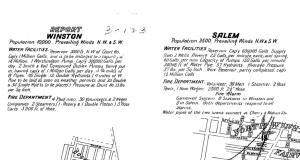
- 1896 - The Raleigh News & Observer on August 13, 1896, reported that
a colored fire company form Winston named the
Hook and Ladder Company attended the 1896 convention in Wilson.
- 1905 - The Winston H. R. No. 1 Company and Winston H. and L. No. 2, Company
are listed in the 1905 conference proceedings.
- 1923 - The Red Hots fire company is listed in the
1923 conference proceedings.
Career Era
The first career firefighters in the merged towns of Winston-Salem were
hired in March 1951. They were Raphel O'Hara Black, Willie James Carter,
Lester Edward Ervin Jr., John Henry Ford, Robert Lindsay Grier, John
Franklin Meredith Jr., George Waddell Penn, and John Roy Thomas. They
reported for duty on March 1, 1951 to Station 4 on Dunleith Avenue. They
received $192 a month during their six weeks of training. The fire company
(Engine 4) consisted of eight black firefighters and seven white officers.
They operated as integrated fire company, but with segregated living
quarters. City laws required separate sleeping quarters and kitchen. It cost
$10,000 to renovate fire station. The company was limited to fighting fires
in African-American neighborhoods until June 2, 1951, when they were called
to assist at the Wood Finishing Products Company Plant #652 on Waughtown
Road. Engine 4 became an all-black company by 1957. The entire fire
department was integrated by November 1967.
top
Copyright 2025 by Michael J. Legeros






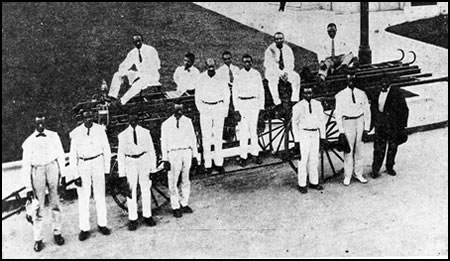




















![[Image]](images/pict1.jpg)

















